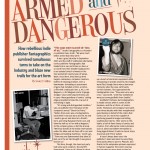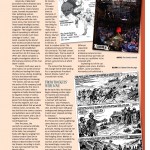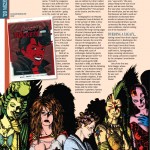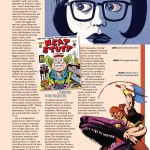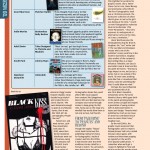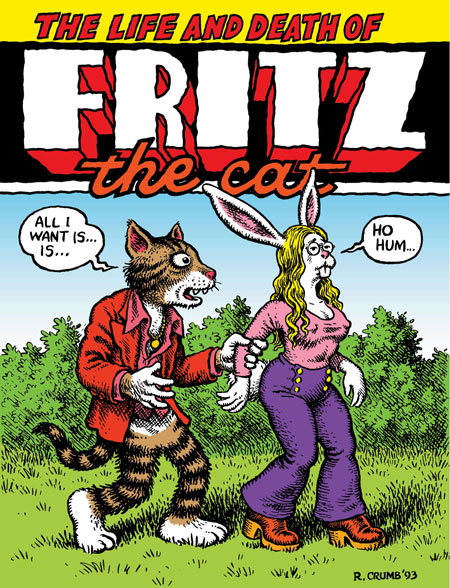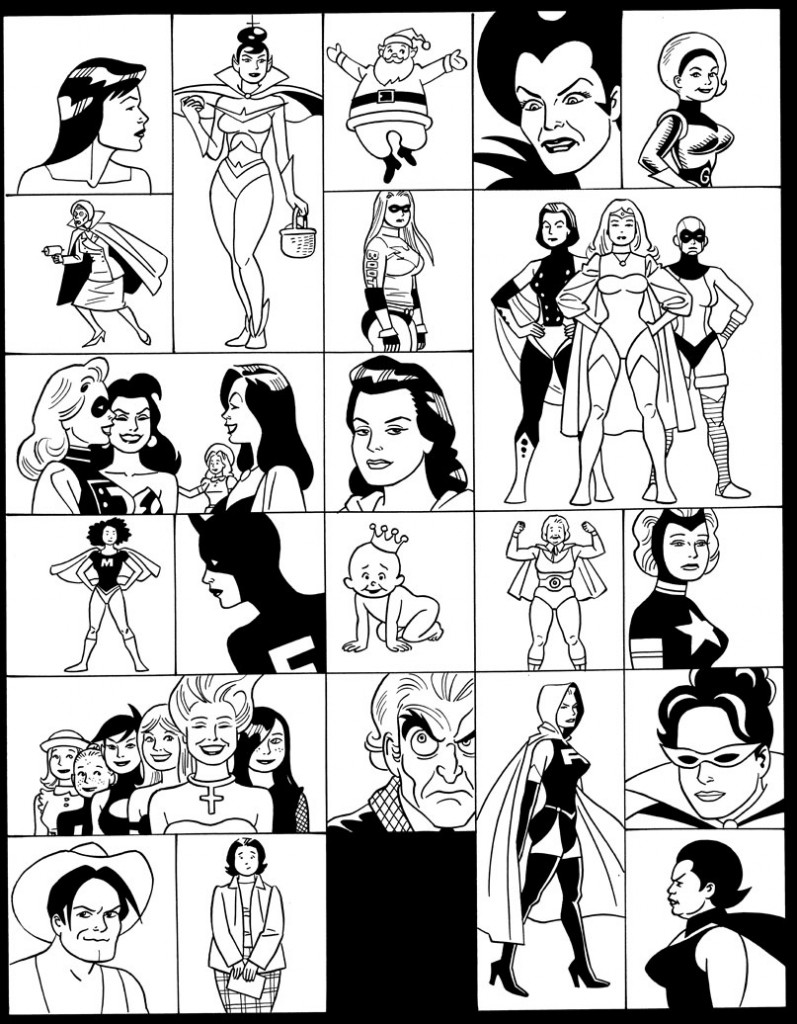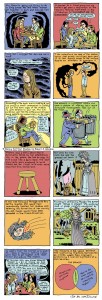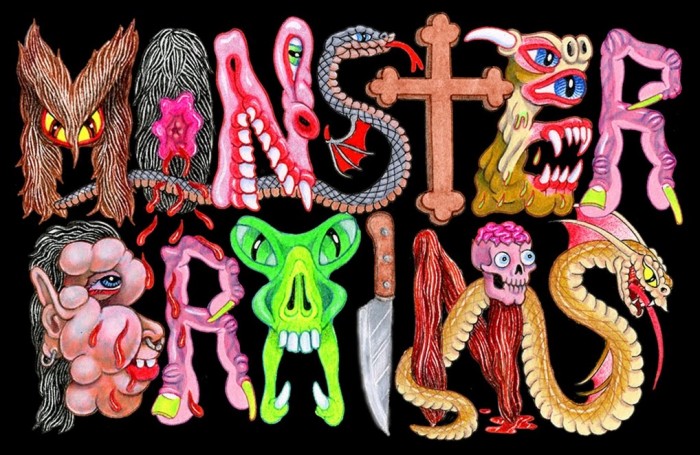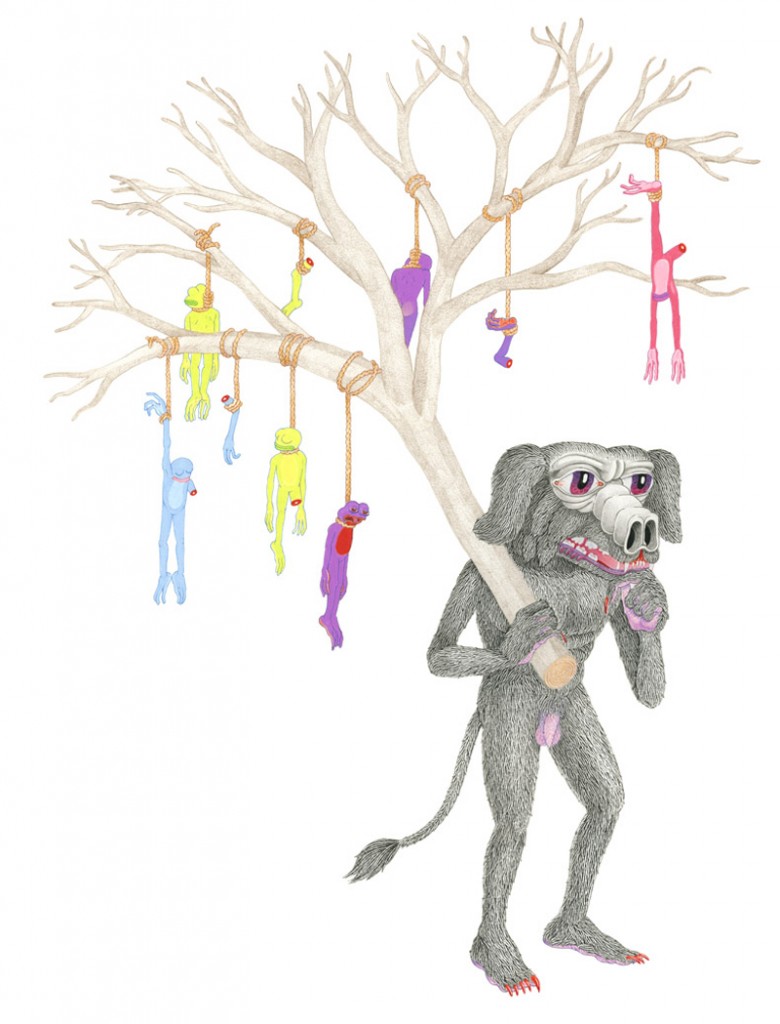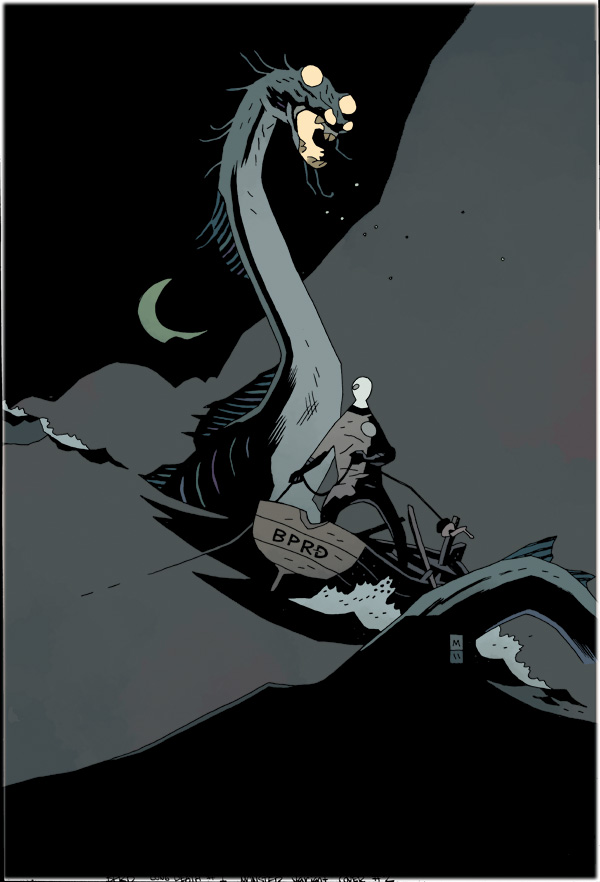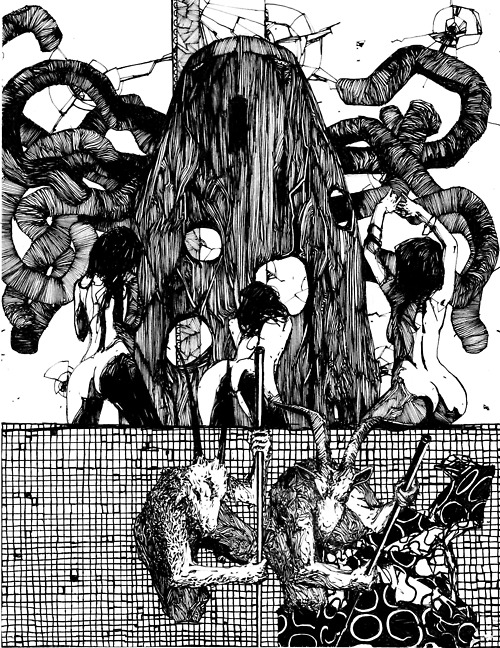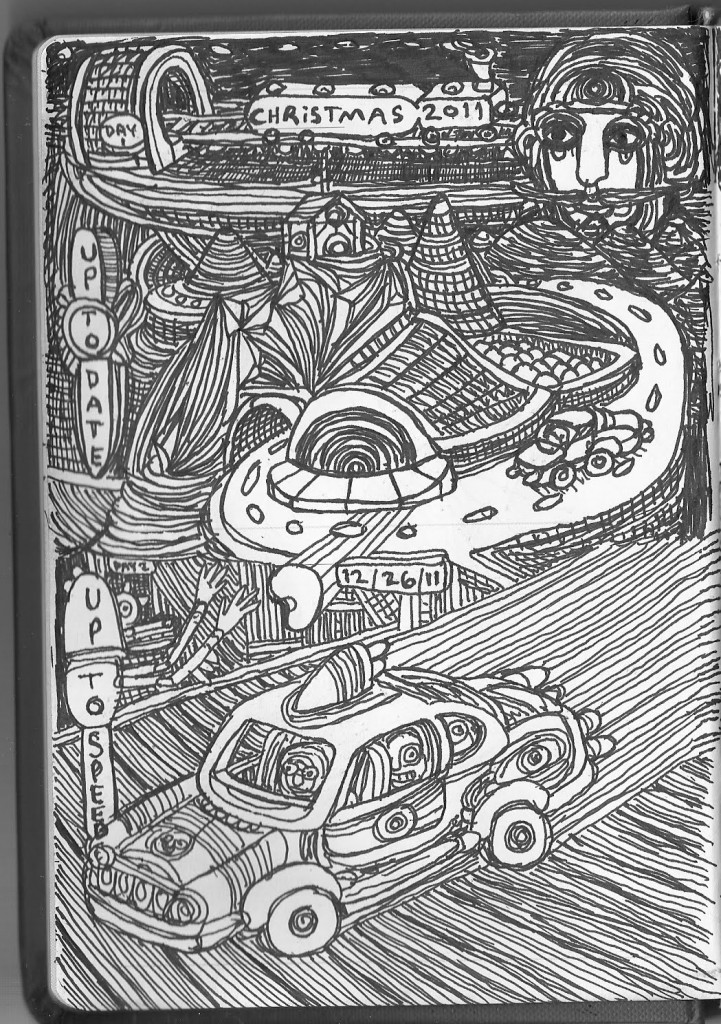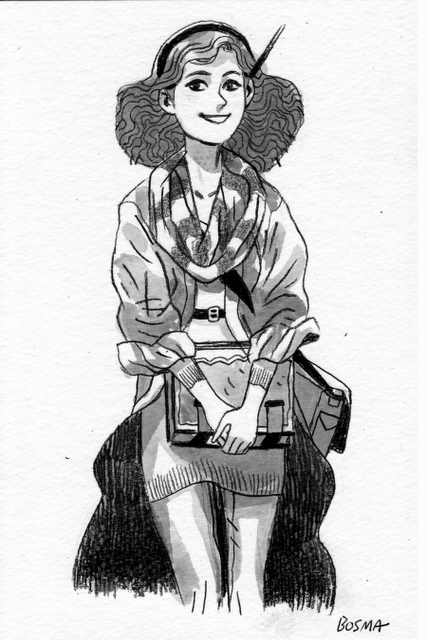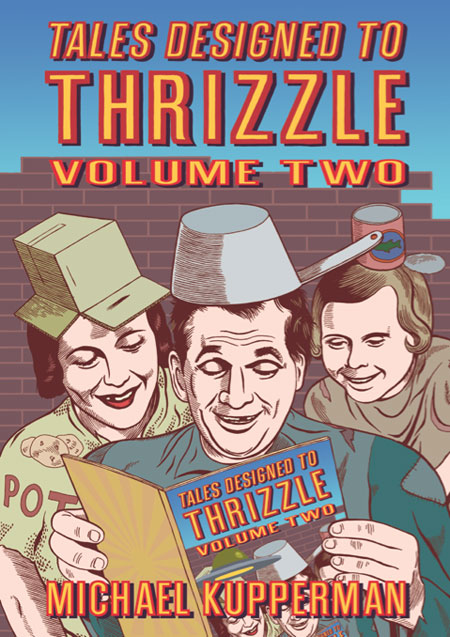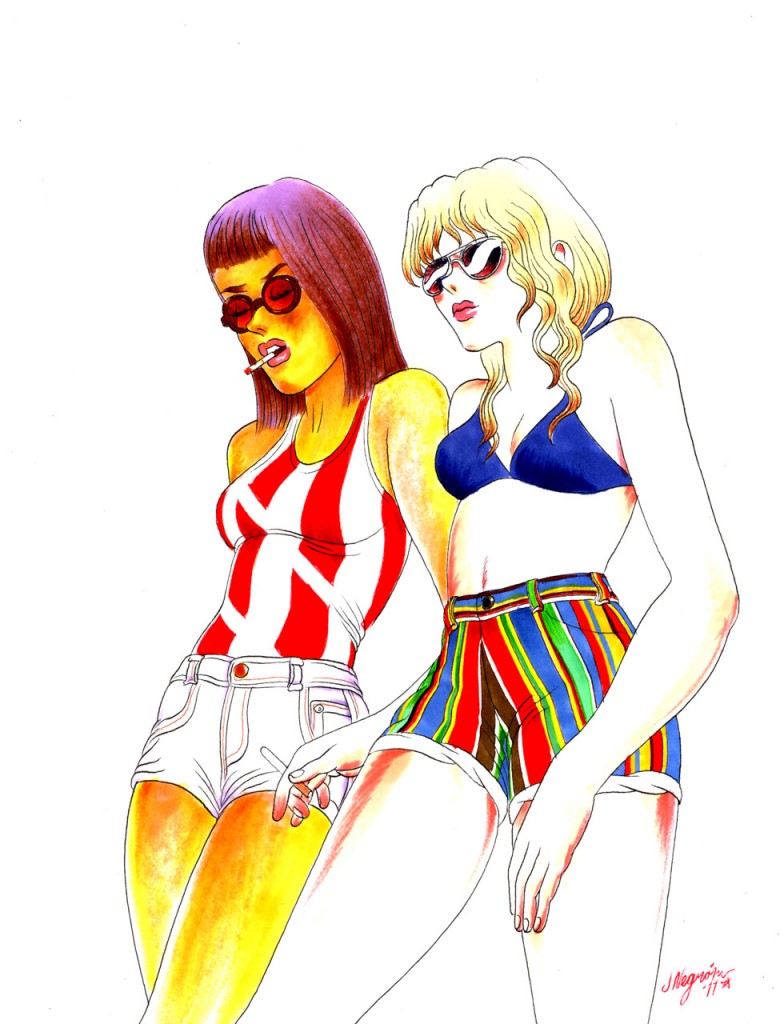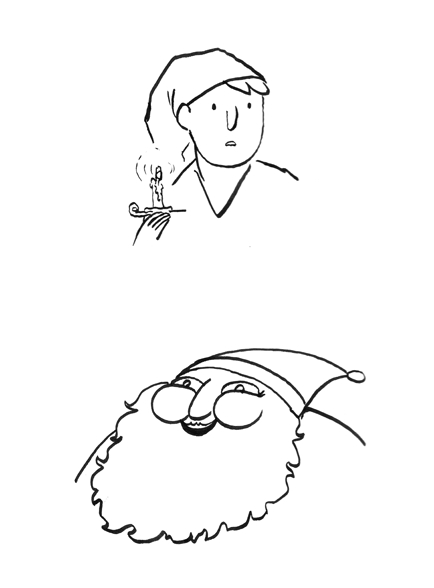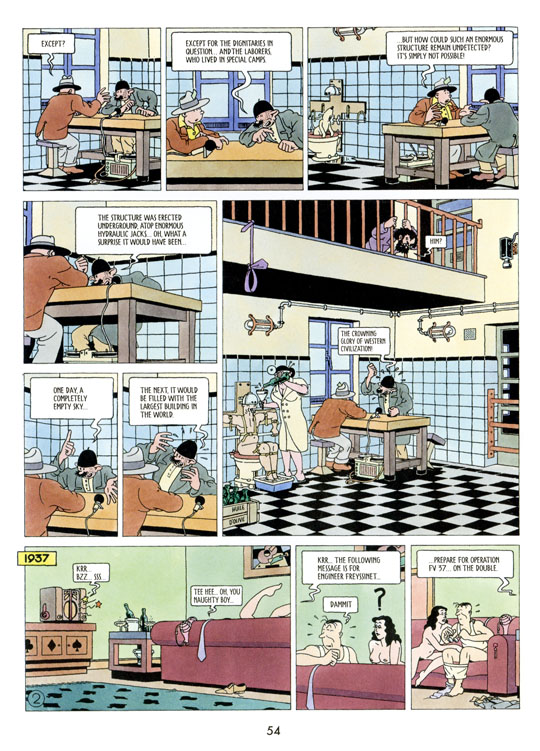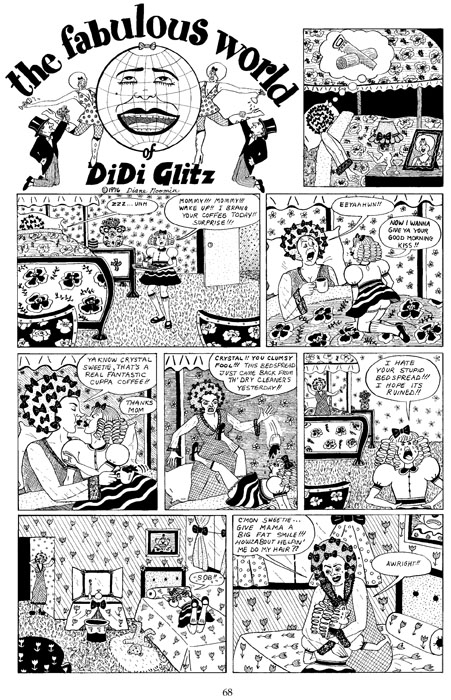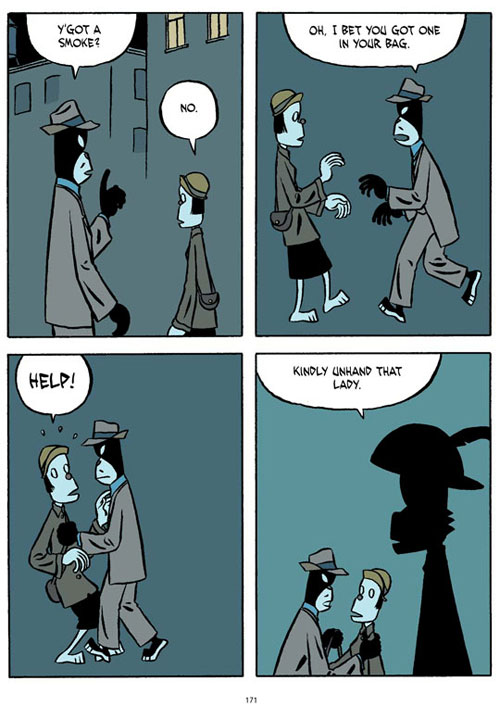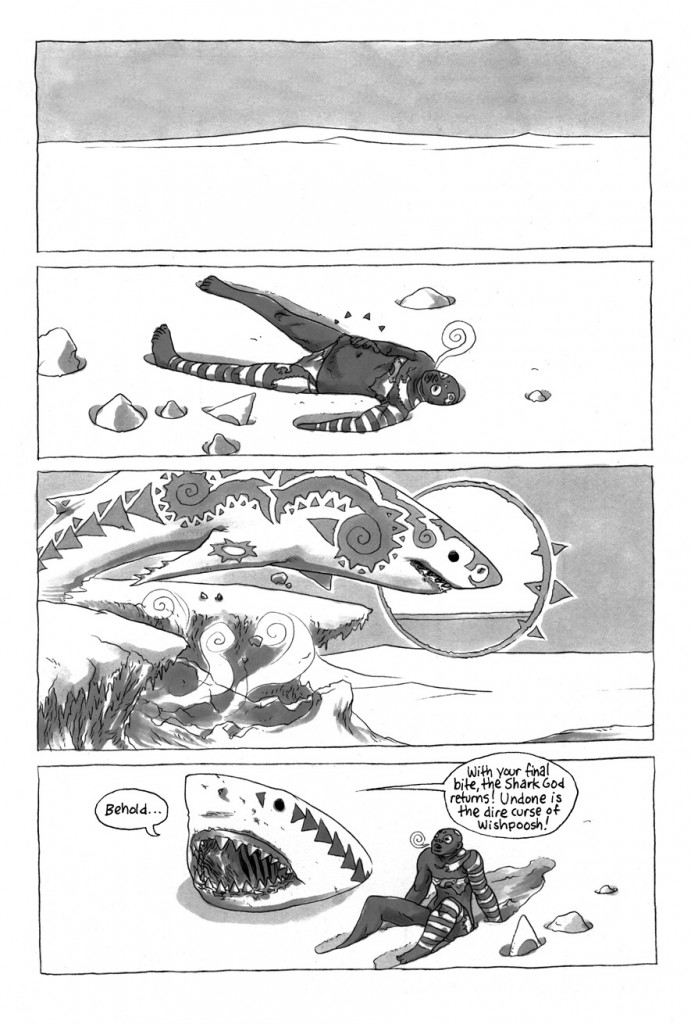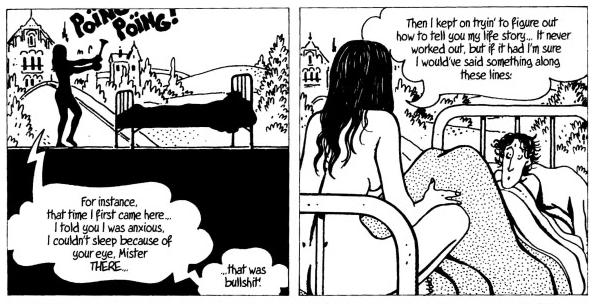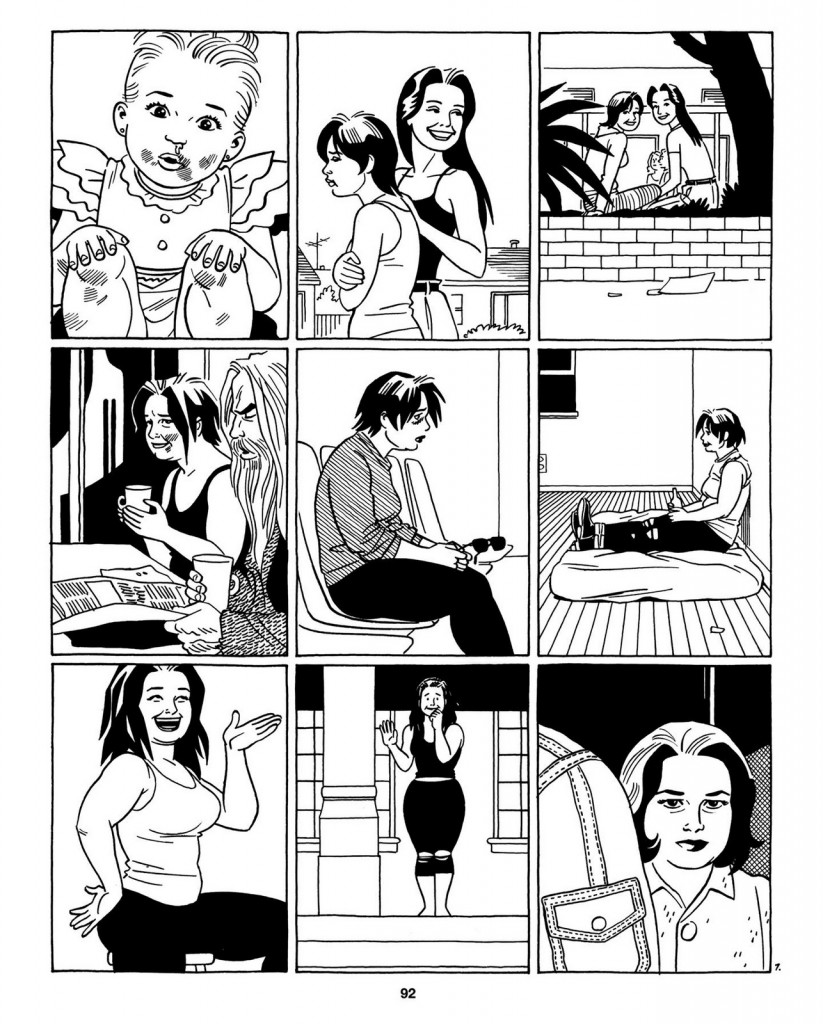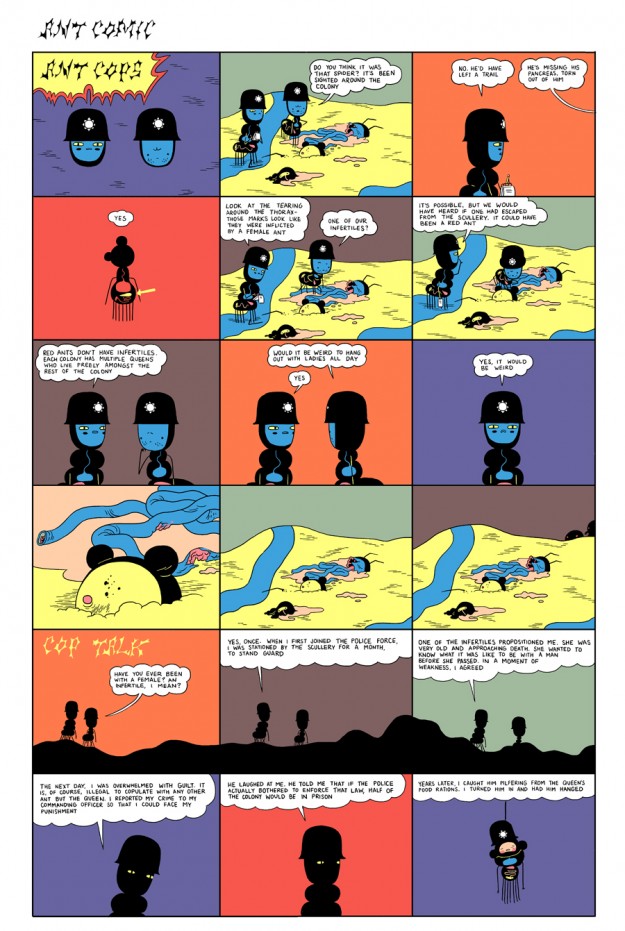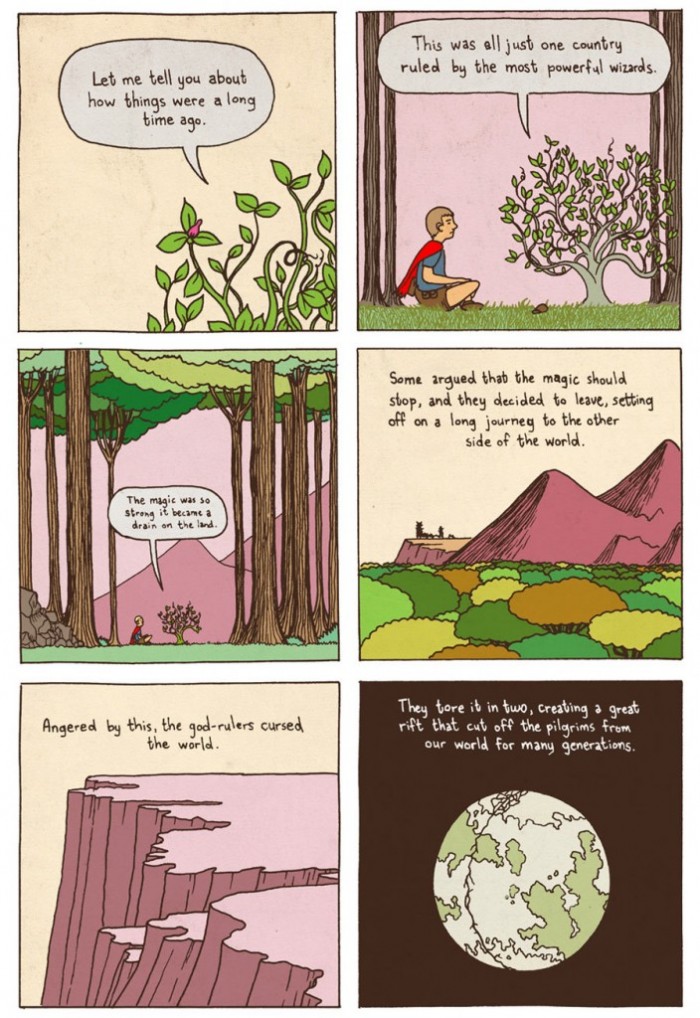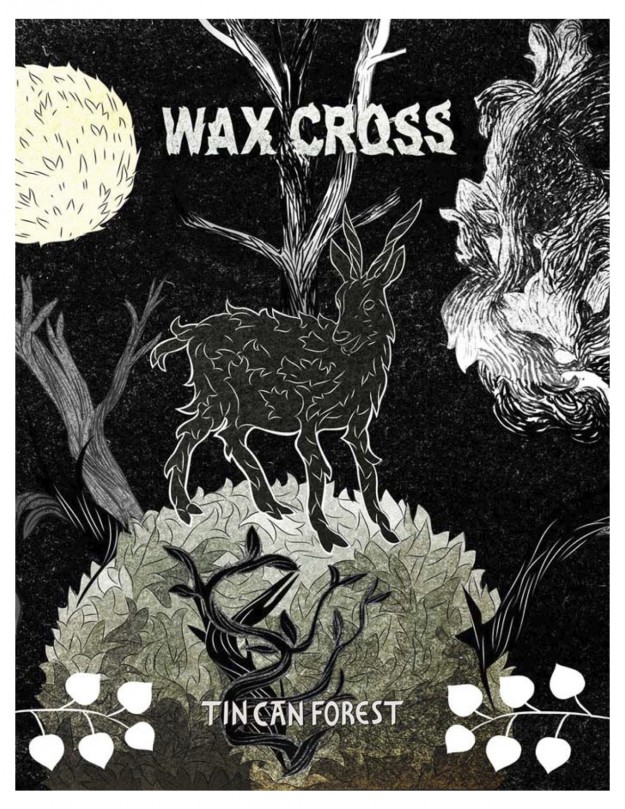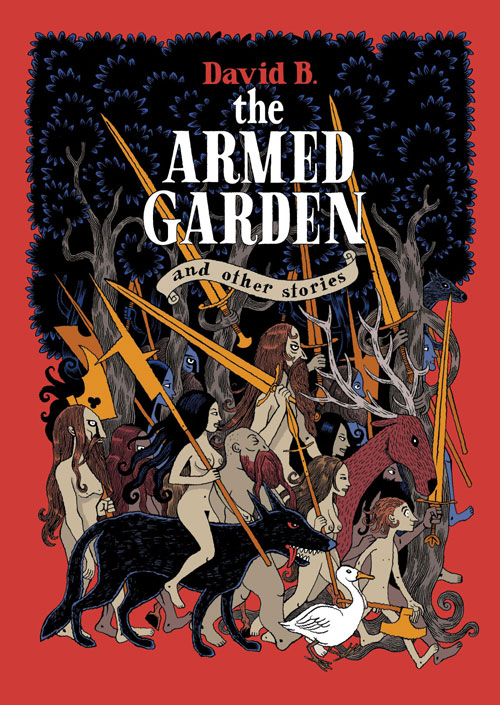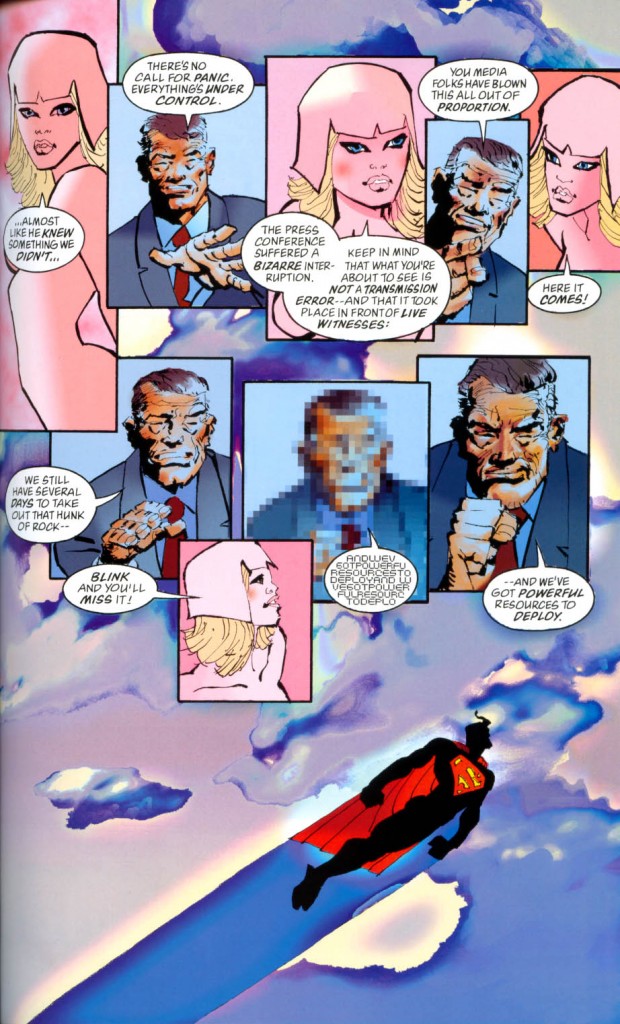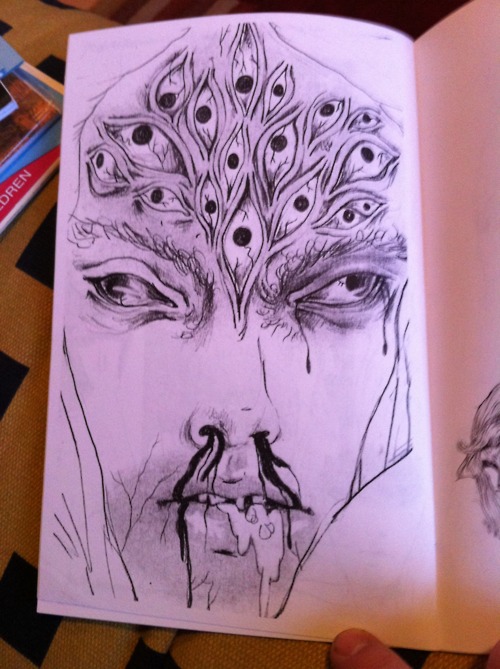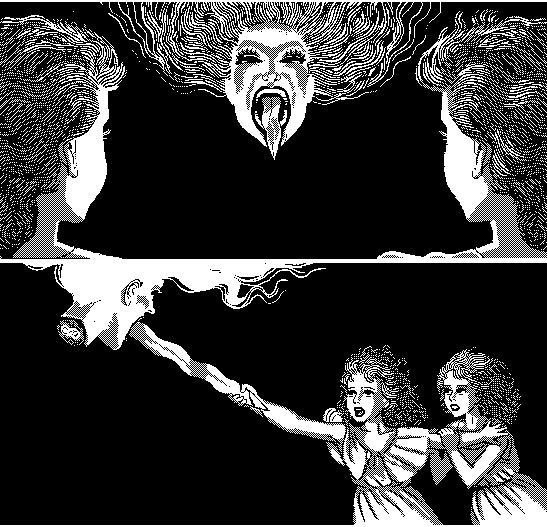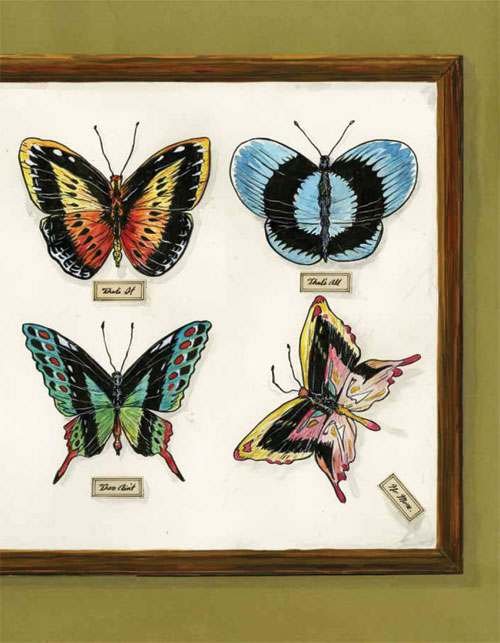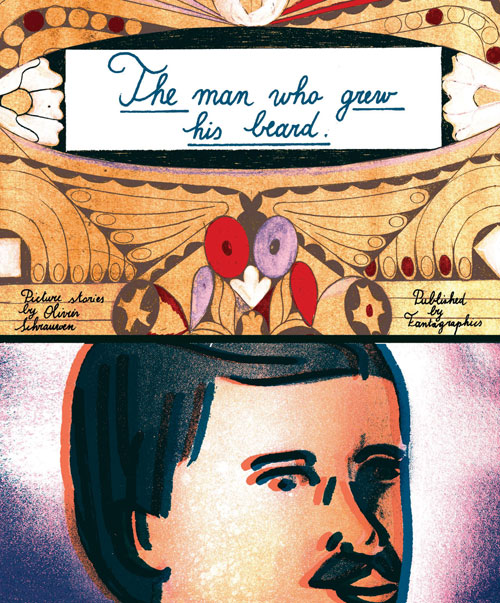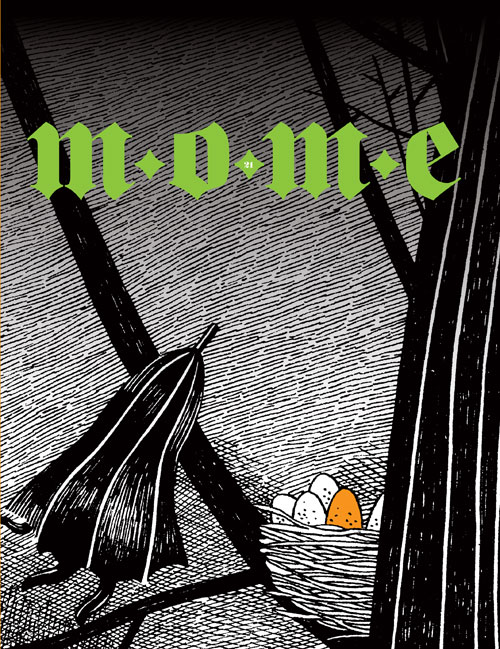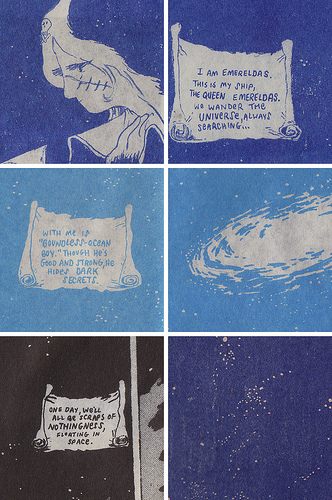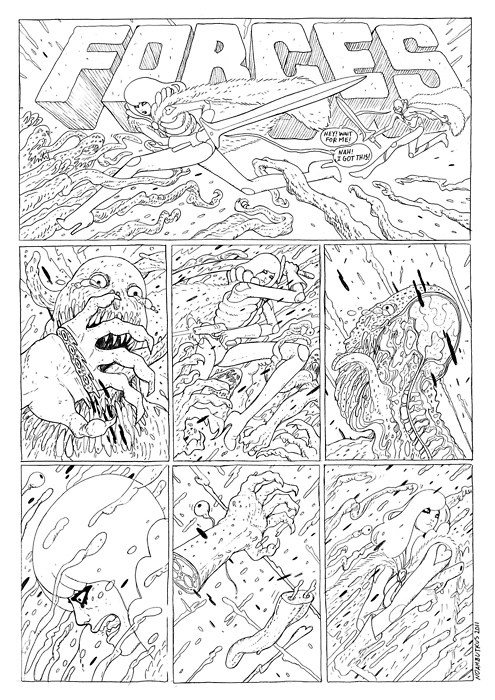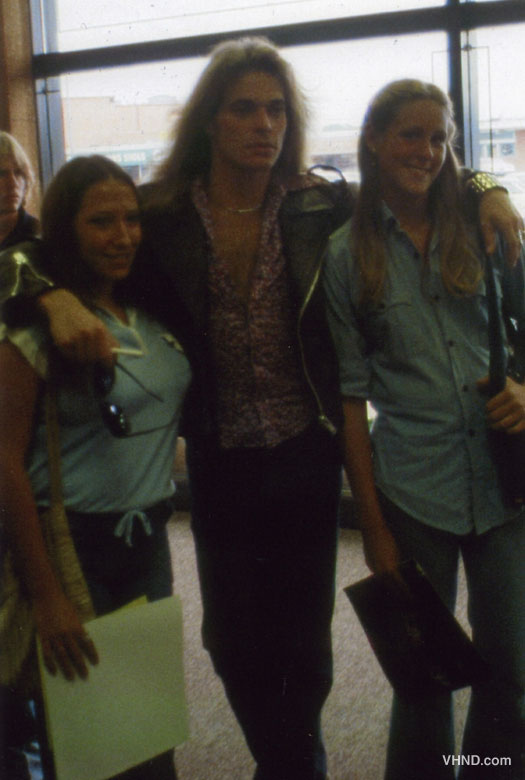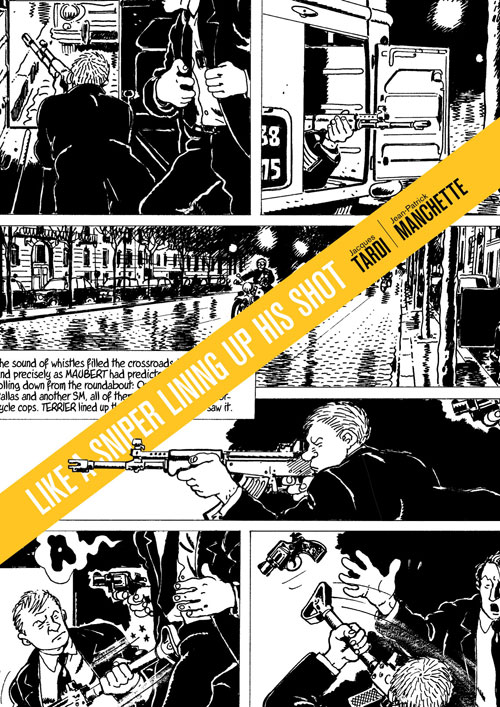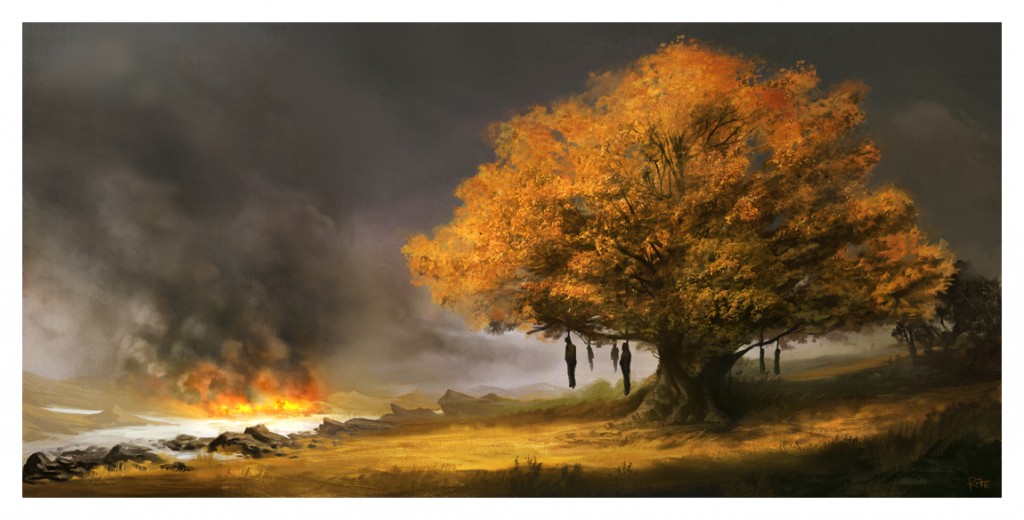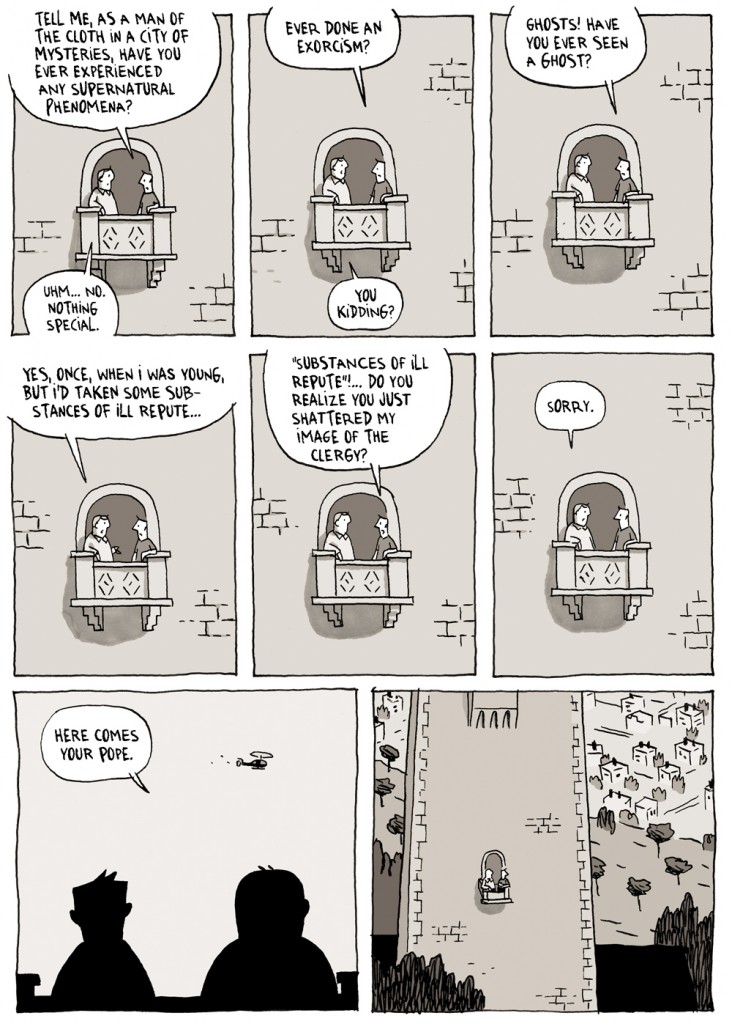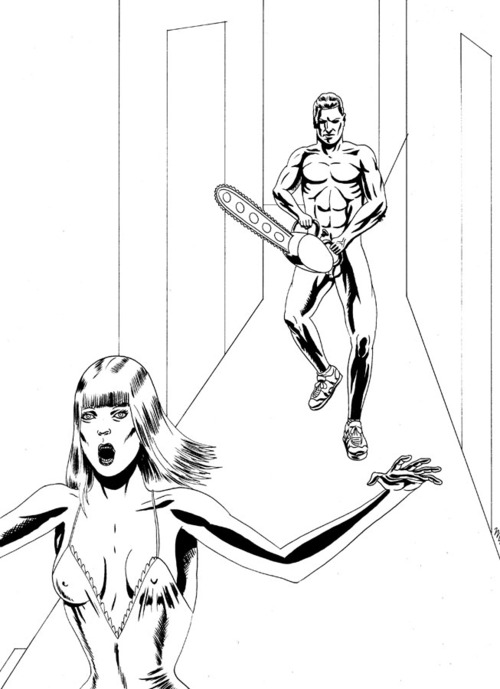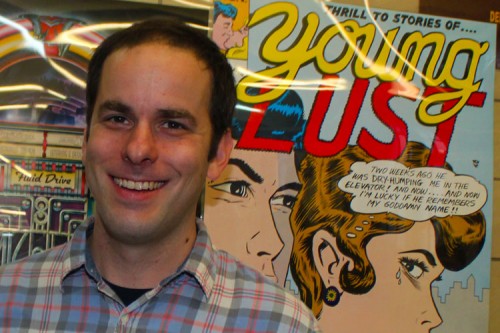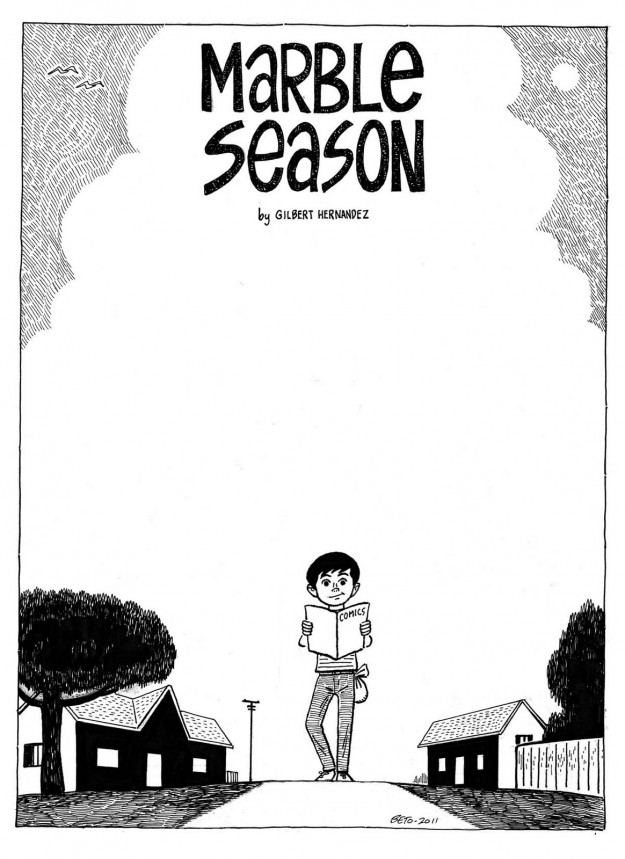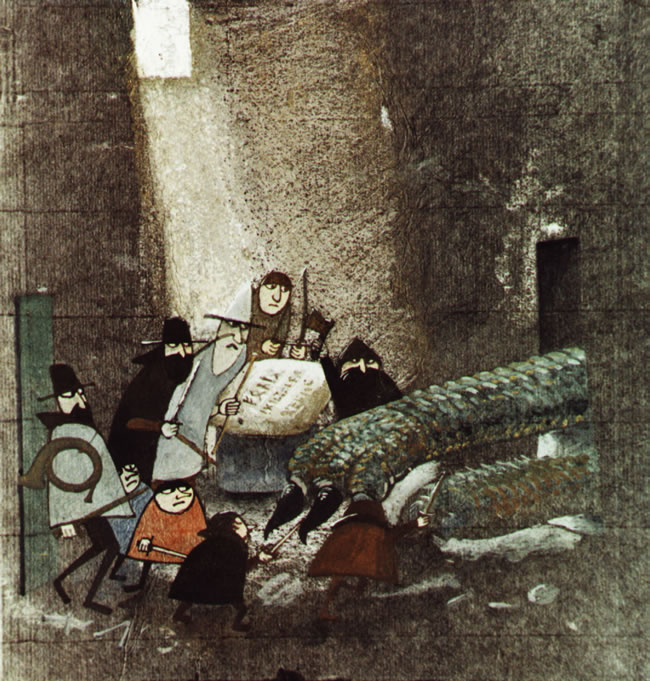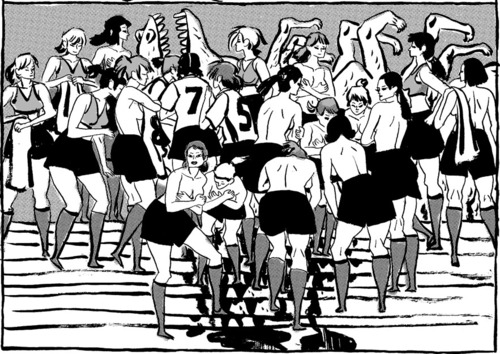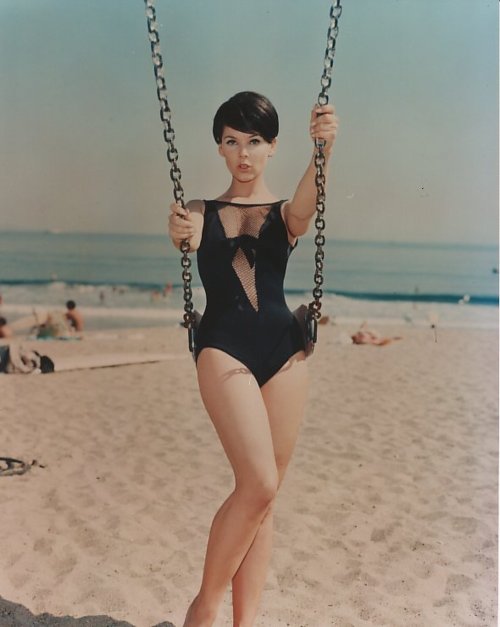Posts Tagged ‘comics’
Carnival of souls: Love and Rockets, New 52 fallout, more
January 12, 2012* Wow: Fantagraphics is publishing two books about Love and Rockets this year. One’s a companion volume with interviews, unpublished art, character guides, family trees, and so forth; one’s a Love and Rockets Reader with essays by Marc Sobel. Pretty great timing given that the series is getting as much attention now in its 30th year as it ever has, because it’s as good as it ever was.
* Marvel beat DC in dollar share and market share in the direct market in December. Think for a moment about everything that changed not just at DC but across the entire industry — some for the good, some for the bad, some for the “jury’s still out” — in the name of what amounted to a three-month sales goose. Same-day digital pretty much industry-wide, new continuity, new costumes, all the redundancies and obsolescences created by same in everything from licensing to ongoing storylines to planned and abandoned storylines to licensing images to the recently launched DC MMORPG, a new business model in terms of release schedules for DC, a competing new business model in terms of release schedules for Marvel, a new way of working with talent, new internal procedures for editing and trafficking books, various controversies over race and gender and sex, hirings and firings of creative personnel, new baselines for page count and price point, big-name writers carving out little bubbles of continuity-independence for their books, major media pushes, a shaky retail sector adjusting on the fly to all of the above…and Marvel beat DC in December. Really, really, really remarkable. Tom Spurgeon has more analysis, including the always welcome remonstrance that publishers who complain about the inaccuracy of publicly available sales estimates have it within their power to provide more accurate numbers in seconds, and on a basis more comprehensive than crowing about sellouts when it suits them.
* Speaking of Spurge, I enjoyed quite a few of his final “holiday” posts, including his interviews with Laura Hudson and Chester Brown and his New Year’s resolutions, at least two of which can be summed up with “Don’t be an asshole.”
* I have a pretty low tolerance for other people’s opinions on David Bowie’s songs — through no fault of its own there are few things I’d rather read less than that one blog that’s writing about every single Bowie song in order — but I sure did enjoy Matthew Perpetua’s take on “TVC-15.”
* Michael DeForge’s latest Ant Comic manages to be the most awful one yet.

* Gorgeous cover for SF Supplementary File #2C by Ryan Cecil Smith.
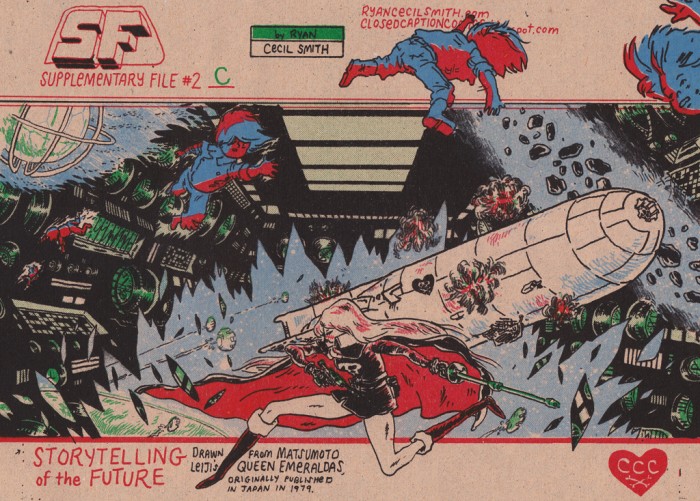
* Lisa Hanawalt does War Horse.
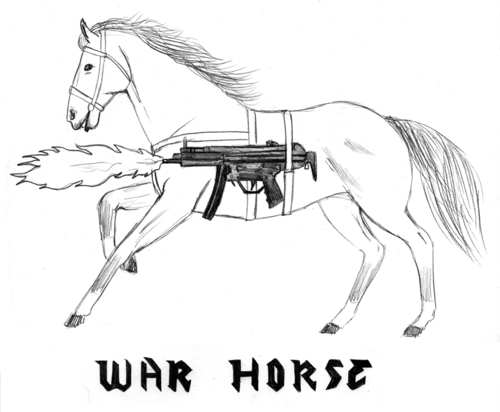
* Plenty of interesting work being discussed in Kevin Czap’s fifth and final BCGF haul roundup.
* Panels of 2011 is an accurately named and visually compelling new tumblr.
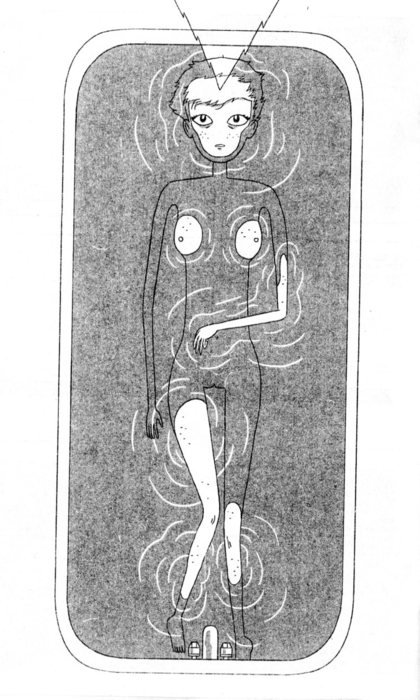
* Kali Ciesemier sketches Robyn.
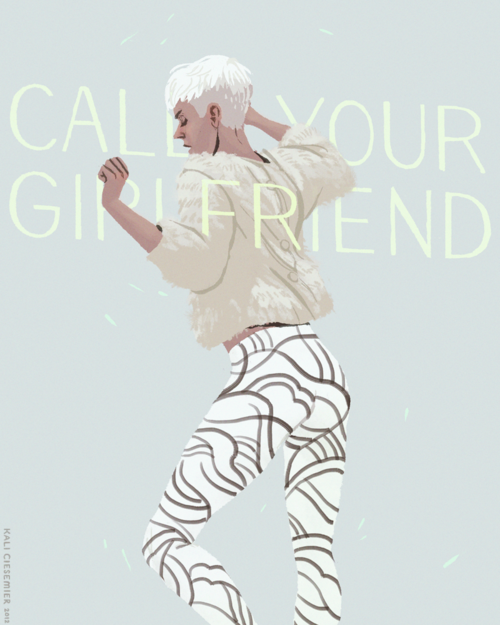
* I’m historically not the biggest fan of the writer doing the adaptation, but the coming Conan comic being illustrated by Becky Cloonan will at least look as good as Conan comics have ever looked.
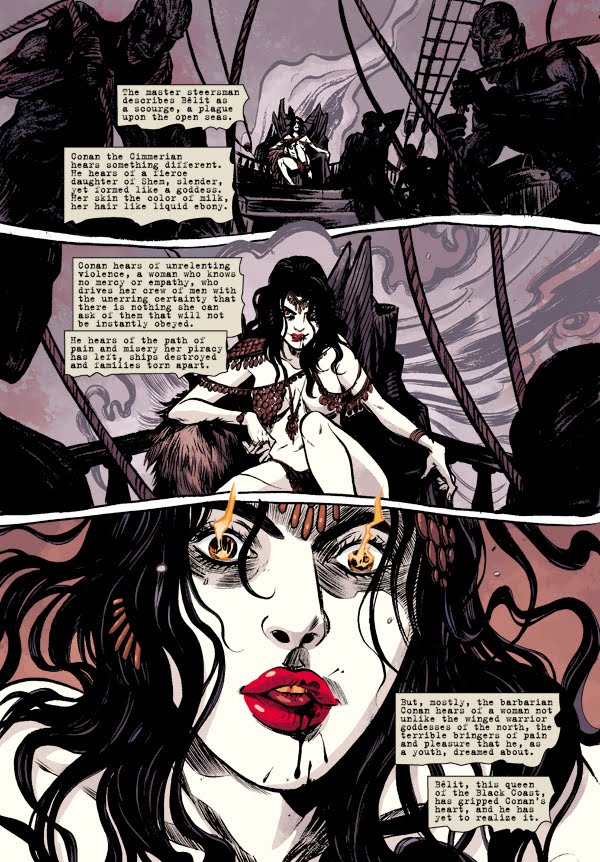
* Man did I like that one At the Drive-In record, a pretty peerless effort in terms of coming up with lyrics that demand to be shouted. DANCING ON THE CORPSES’ ASHES!!! Glad they’re getting back together.
* Real Life Horror: When is terrorism not terrorism? Related: I wish I’d bookmarked the post where he first made this connection, but in light of the apparent secret campaign of orchestrated murder against Iranian scientists it’s worth reiterating Greenwald’s contention that the wall of state secrecy behind which the United States hides violent overseas acts like these assassinations and our multinational drone wars is in every important way equivalent to the more voluble propaganda to which our despotic enemy regimes subject their populace, propaganda which we never fail to decry when we see it in others. The North Korean who believes the birds are crying over the death of internationally revered statesman Kim Jong-Il is not a world apart from the American who doesn’t know about all the children slaughtered by our army of flying killer robots.

* Gary Groth on his dinner with Christopher Hitchens.
* Go home and get your fuckin’ shinebox, AMC.
* Finally, behold the awesome power of Pizza Boomerang.
The history of Fantagraphics
January 10, 2012Here’s a six-page profile of Fantagraphics I wrote for Wizard a few years back, tracing it all the way from Gary Groth’s dorm room to its post-Peanuts, post-graphic-novel-boom salad days and featuring appearances by Gary Groth, Kim Thompson, Daniel Clowes, Jaime Hernandez, Paul Hornschemeier, Brian K. Vaughan, and lots and lots of guns. Click the images below to read, or download the whole thing as a PDF. Enjoy!
Carnival of souls: Special “not a special edition” edition
January 6, 2012* Chris Mautner lists “The Six Most Criminally Ignored Books of 2011.” Shame on me for not having read Pure Pajamas yet, that’s for damn sure. (Noel Freibert’s Weird, too.)
* Fantagraphics is showing off covers for R. Crumb’s The Life and Death of Fritz the Cat and Jaime Hernandez’s God & Science: Return of the Ti-Girls. (I think my favorite thing about Jaime’s superhero team is how fans would no doubt debate how to properly pronounce their team name, a la Magneeto/Magnetto, Naymor/Nahmor, etc.)
* It wasn’t until I grabbed the jpg of Gabrielle Bell’s latest comic in order to drag it to my desktop and crop out a panel for posting here that I saw just how lovely the background colors look in relation to one another. See what I mean?
* Grant Morrison talks about Dr. Octagon.
* Ben Morse’s Big Two(ish) Best-Of continues.
* Finally, Monster Brains has unleashed the Furie with a beautiful Matt Furie gallery and a spiffy new Furie-designed logo.
Carnival of Souls Post-Holiday Special #3: Comics and Art
January 3, 2012* Best Comics of 2011 Lists I Whiffed On #1-2: Tucker Stone contributed two different, very fine lists, one to comiXology and one to FlavorWire. The latter is couched as “the year’s most buzzworthy books” (somehow that explains the slideshow format to me), but Tucker’s writing strictly about whether they were any good. You could use these two as a shopping list and be really happy with your purchases, I suspect. If ComicsAlliance’s list was the best-looking best-of, these are the best-written ones, at least as far as I’ve seen. (The FlavorWire link comes via Dan Nadel.)
* Best Comics of 2011 Lists I Whiffed On #3: Frank Santoro at The Comics Journal. I really could have sworn Puke Force was from 2010 or it would have made my list this year.
* Speaking of Frank, he’s launching his Comics Correspondence Course’s spring session.
* Perfect listening for the next time my baby decides to spend 1am-3am refusing to go to sleep whenever I put her down: Tom Spurgeon talks Gilbert Hernandez on the Deconstructing Comics podcast.
* Dylan Williams’s friends and family have created a tribute blog for him, archiving everything from Amazon reviews he wrote to zine art he drew to personal photos of him.
* In light of recent events in the series, I’m glad to hear from Mike Mignola about his plans for Hellboy, because the nature of those plans makes me slightly less irritated about having said events spoiled for me by PR. Also this looks an awful lot like the BPRD versus the Loch Ness Monster, which gets MY FULL SUPPORT. (Via Robot 6.)
* Hey, it’s a video trailer for Chuck Forsman’s excellent minicomic series The End of the Fucking World.
* Did you know that Zak Smith/Sabbath has a sketchblog, by which he means a finishedartblog? I sure didn’t.
* Speaking of crazily maximalist art for which the term “sketch” is wholly insufficient, Theo Ellsworth will be drawing a sketchbook page before bed every night for a year.
* I don’t really care about Harry Potter — perfectly nice but hugely flawed books with a rotten ending that I probably wouldn’t have ever thought of again after finishing them if not for the fact that they’re a world-historical publishing and film phenomenon, and also Emma Watson — but I certainly care about Sam Bosma’s set of Harry Potter character portraits.
* I think this is just a recolored panel from “Jeepers Jacobs,” but I sure hope it’s a sign of where Kevin Huizenga is headed with his palette.
* Oooh, look: Tales Designed to Thrizzle Volume Two!
* Nor you, Dave Kiersh.
* Wow Cool has opened up a special Press Gang store in honor of the new Portland small-press operation, and just added a whole bunch of other stuff besides.
* Kevin Czap continues reviewing his BCGF haul.
* William Cardini presents an Austin, Texas Scene Report for Frank Santoro’s Comics Journal column.
* Finally, a belated Merry Christmas from Kate Beaton!
Carnival of Souls Post-Holiday Special #2: Best-Ofs and Blowouts
January 3, 2012* I bookmarked enough year-end best-of lists and special-feature marathons to merit their very own Carnival. I hope you’re hungry!
* Here’s CBR’s Top 100 Comics of 2011 master list. My own top 10 was factored into the voting. While superhero comics are more dominant toward the top than they were last year, and while I don’t really understand why people would vote for half a story which is basically all that all of DC’s New 52 comics have produced so far, I’m still happy to see books like Love and Rockets, Garden, and Big Questions make the Top 5, Top 20, and Top 25 respectively on a staff-voted list for a superhero-driven site like CBR. Lists like these are also useful for seeing which non-superhero books were “the one” that superhero readers not only felt behooved to read but enjoyed as well — this year it looks like Hark! A Vagrant and Habibi take that title.
* You can also find my personal 20 Best Comics of 2011 list among Robot 6’s favorite comics of 2011. Unsurprisingly to me I’m most simpatico with Chris Mautner’s strong list, but I I’m interested in it as much for the difference as for the similarities: I just couldn’t get into Yuichi Yokoyama’s Color Engineering (his painted work has little visual appeal for me and the decision to relegate the translation of the text to literal footnotes completely negated his comics’ normal immersive appeal), I didn’t include any archival reprints, there are certain old-school-style alt-comics that didn’t hit me in the same way, and I never got to read that Winshluss Pinocchio, to my chagrin. However, the real gamechanger in this post is Matt Seneca, who ranks his own comic as the year’s third best, behind only Yokoyama’s Color Engineering and Garden and seven slots ahead of Love and Rockets: New Stories #4 by Gilbert and Jaime Hernandez. In this light I wonder if I should revise my list to include my webcomic Destructor, which using the Seneca scale of “Los Bros + 7” would rank as the Negative Sixth Best Comic of the Year. On the other hand, perhaps I should follow Matt’s lead and allow that as many as two comics published in 2011 might well have been better than my own. I wouldn’t want to be gauche!
* Robot 6 celebrated its third anniversary with a comically massive amount of very exciting interviews and previews and news and so on. You can find the complete list of anniversary posts here. I’ve already linked to my contributions; here are some of the highlights from my colleagues.
** Tim O’Shea interviews Tom Scioli about his webcomic and forthcoming AdHouse collection American Barbarian. Though I’d never thought of this in quite this way before, this quote is dead on:
AdHouse’s line seemed to me to be carefully curated. Each release really counts. It’s gotten to a point where each new AdHouse book is kind of an event, you know? The Josh Cotter books, then Afrodisiac, then Duncan the Wonder Dog, Pope Hats, Forming. I feel like AdHouse has had this great track record of quality, where I’m benefitting from that goodwill, that American Barbarian is the next AdHouse book and that that means something. I think it’s a great way to have your work presented.
** Here’s an exclusive preview of Fantagraphics’ stunning-looking Is That All There Is? by Joost Swarte. Super-excited to see a near-comprehensive Swarte collection in English.
** And here’s an exclusive preview of Fantagraphics’ equally comprehensive collection of Diane Noomin’s DiDi Glitz comics, Glitz-2-Go. I love how unapologetically underground it looks.
** AND here’s an exclusive preview of Fantagraphics’ latest big Jason hardcover, Athos in America, an all-new collection that contains a prequel to The Last Musketeer.
** Read Ross Campbell’s Mountain Girl #2 in its entirety.
** Finally, Robot 6 asked a plethora of critics and creators what they’re most looking forward to in 2012. The responses from Campbell, Inkstuds’ Robin McConnell, and Rub the Blood co-editor Ian Harker stood out to me. On a personal note, my friends Ben Morse, Justin Aclin, Jim Gibbons, Rick Marshall, and Ryan Penagos also all weighed in.
* My Comics Journal overlords Dan Nadel and Tim Hodler listed their favorite posts from their first year running TCJ.com. Interviews, reviews, features, columns, journalism, you name it — it’s a terrific selection from a huge range of writers. Just don’t read the comment thread, wherein TCJ.com message board Lost Causers make like Faulkner writing about the last moments before Pickett’s Charge.
* Tom Spurgeon’s holiday interview series continued all week long, and you can find the complete list here. I’ve already linked to some early favorites; here are a few more.
** Tom interviewed Peter Birkemoe of the acclaimed Toronto comics shop/art dealership/TCAF co-sponsor The Beguiling. It’s easy to see Birkemoe as one of those people involved in the retail end of comics who has created a center of gravity around which a whole vision of comics can coalesce, like a Rory Root or Tony Shenton. However, as I pointed out on Robot 6, he also sounds a warning bell about how digital comics and books will take a toll even on an enlightened shop like his.
** Tom interviewed Kim Thompson of Fantagraphics, primarily but by no means solely about his efforts in translating and publishing European comics. Getting Jacques Tardi over with American audiences is a Top 20 achievement in comics publishing since the turn of the century, for sure. (Man I love the way Tardi drew Julie in You Are There. Hubba hubba.)
** Tom interviewed Secret Acres co-publishers Barry Matthews and Leon Avelino. I had no idea that Avelino was a Highwater Books baby like Randy Chang, or in all honesty like I like to sit around daydreaming that I myself was. The picture that emerges from both men is one of intense consideration and thoughtfulness in terms of what books they publish, the way they work with their authors, and their relationship to the comics market.
** Finally, Tom interviewed my Robot 6 and Comics Journal colleague Chris Mautner about the year in alternative and art comics. I found this interview truly reinvigorating. It’s pretty much a list of a couple dozen reasons to be excited by comics right now and explains why they’re exciting, and those reasons once again run the gamut from old hands to new blood. (On a personal note, I’m also pleased to see I helped get Jonny Negron on his radar.) I like Tucker Stone a lot, and his straightforward comics writing is among the best in the business, but his his vituperative interview with Tom about the year in mainstream comics knocked the wind out of my sails like you wouldn’t believe. Immoral and unethical business practices are one thing, but the Kirby/Shuster/Friederich 2011 hat trick of horror aside I just don’t associate the act of reading comics, or interacting with people involved in their production and reception, with misery and rage like he does. It’s a conception of the art form and interacting with it as a critic (especially since it seems so closely tied to really going after individual artists whose work is seen not to pass muster) that’s totally alien and unpleasant to me, even when I’m writing about comics I don’t like and explaining why. It’s even more dispiriting when I see how many critics and cartoonists seem to love that approach and feel the same. Plus, Tucker’s such an incongruously sweet guy in person that it just makes me want to make like Wesley and rescue his Princess Buttercup from the Prince Humperdink of daily interaction with a business and its products he hates. After all that, Chris’s interview really felt like the wind beneath my wings. (And it’s not as though he minces words about the stuff he doesn’t like, mind you — the overall tone is just so much less geared toward what an Imperial official might refer to as finding a weak point and exploiting it until the whole thing blows up.)
* Any list that names the actual best comic of 2011 as the best comic of 2011 deserves our support, and as such I’m happy to direct you to ComicsAlliance’s 11 Best Comics of 2011, which ranks Love and Rockets: New Stories #4 at Number One. Like the CBR list it’s insufficiently snobby for my pinky-in-the-air tastes — the titles run along CA’s usual lines of “I’m not a regular nerd, I’m a cool nerd,” i.e. smarter genre work from the Big Four publishers plus accessible work from the arthouses — but each entry is passionately and intelligently argued, and illustrated with well-selected and beautiful art samples. It’s probably the best looking of all the best-of lists I’ve seen; Laura Hudson’s picks for Finder in particular are a “hey, I should check this out” batch. And even though I disagree with writer Jason Michelitch’s argument that you absolutely should not read New Stories #4 until you’ve read all of Jaime’s Locas work, I’m psyched that he made that argument and really went to bat for it. There are a lot of ways to approach that book and it’s exciting to see them explored in a rigorous way like that, especially since the comic’s so emotionally moving (see Mitchelitch’s write-up for an example) that you could get away with just cheering for it.
* At the Cool Kids Table, Ben Morse picks his (mostly) Big Two best.
* Finally, George R.R. Martin looks back on his amazing year. It started with him in the hospital after nearly dying, and ended with him married, with the best sales and best reviews of his career, and with both TV and publishing phenomena to his name, and with more personal moments of recognition that clearly meant a lot to him. It all makes for heartwarming reading.
Carnival of Souls Post-Holiday Special #1: My Stuff
January 3, 2012* I hope you enjoyed your holidays! While you were out, I kept pretty busy. Here are some links to what I’ve been doing.
* I posted my list of the 20 Best Comics of 2011. It’s exciting to me that old established Grand Masters are about as well represented on it as people whose first comics came out after Obama was elected, and of course there are plenty of people in between as well. It’s also exciting to me that many of the cartoonists represented there are creating huge, consistently high-quality bodies of work without a regularly published solo series as their main venue or even as any venue at all, instead or in addition turning to anthologies, minicomics, and the Internet to get their work to the public. And I haven’t felt this blessed by an abundance of genuinely bizarre and powerful sex-horror stuff since I first discovered Clive Barker’s Books of Blood in 1994.
* Robot 6 celebrated its third anniversary with a massive two-day blowout of exclusive interviews, previews, and assorted other features. I contributed several pieces.
** I interviewed Sammy Harkham about Kramers Ergot 8. I think this is my favorite interview of all the ones I conducted last year. Sammy and I slowly circled around the thinking at the core of the book before finally plunging right into it. It was an exciting conversation to have. (That’s from Takeshi Murata’s contribution to the book below.)
** I interviewed Michael DeForge about the absolutely tremendous 2011 he had, specifically about Ant Comic, Open Country, “Dog 2070” from Lose #3, and “College Girl by Night” from Thickness. I asked a lot of questions about influence and intent, which is a hit or miss proposition, but I think Michael delivered.
** I interviewed the Press Gang triumvirate of Jason Leivian, Zack Soto, and François Vigneault about their plans for their publishing collective. They gave me a lot of exclusive announcements and previews; I think the top announcement is that Soto’s Study Group Comic Books is absorbing Randy Chang’s Bodega Books and taking over publication of The Mourning Star, but beyond that, Leivian’s publishing a book on magick, Vigneault’s Elfworld #3 looks rock-solid, and the line-up of creators contributing to Soto’s soon-to-launch sg12.com webcomics portal is just sick. (There’s no escaping DeForge!) (The page below is from the full-color Danger Country by Levon Jihanian that will be running on sg12.com.)
** And Annie Koyama announced some of her 2012 titles, including new books from Michael DeForge (natch), Julia Wertz, Dustin Harbin, Jesse Jacobs, and Tin Can Forest. You can see covers for the last three at the link.
* In case you missed it, I posted a four-volume mix of the best songs of 2011. (If you were wondering, songs from Underworld and the Game of Thrones soundtrack were cut due to time constraints, because as it turns out the time limit on CD-Rs is actually 79:50, NOT EIGHTY, YOU LIARS, while “Dance (A$$) Remix” was disqualified for the use of the word “anorexic” as a compliment.)
* Finally, I started an A Song of Ice and Fire podcast shortly before Christmas. I’ve posted three episodes so far, in which I’m joined by the Tower of the Hand’s Stefan Sasse in a discussion of honor, morality, and power in Westeros (and Essos). You can find links to all three episodes here. If you like the essays I’ve written about the books or the show, this should be up your alley.
The 20 Best Comics of 2011
January 1, 201220. Uncanny X-Force (Rick Remender and Jerome Opeña, Marvel): In a year when the ugliness of the superhero comics business became harder than ever to ignore, it’s fitting that the best superhero comic is about the ugliness of being a superhero. Remender uses the inherent excess of the X-men’s most extreme team to tell a tale of how solving problems through violence in fact solves nothing at all. (It has this in common with most of the best superhero comics of the past decade: Morrison/Quitely/etc. New X-Men, Bendis/Maleev Daredevil, Brubaker/Epting/etc. Captain America, Mignola/Arcudi/Fegredo/Davis Hellboy/BPRD, Kirkman/Walker/Ottley Invincible, Lewis/Leon The Winter Men…) Opeña’s Euro-cosmic art and Dean White’s twilit color palette (the great unifier for fill-in artists on the title) could handle Remender’s apocalyptic continuity mining easily, but it was in silent reflection on the weight of all this death that they were truly uncanny.
19. The League of Extraordinary Gentlemen Vol. 3: Century #2: 1969 (Alan Moore and Kevin O’Neill, Top Shelf/Knockabout): I’ll admit I’m somewhat surprised to be listing this here; I’ve always enjoyed this last surviving outpost of Moore’s comics career but never thought I loved it. But in this installment, Moore and O’Neill’s intrepid heroes — who’ve previously overcome Professor Moriarty, Fu Manchu, and the Martian war machine — finally succumb to their own excesses and jealousies in Swinging London, allowing a sneering occult villain to tear them apart with almost casual ease. It’s nasty, ugly, and sad, and it’s sticking with me like Moore’s best work.
18. The comics of Lisa Hanawalt (various publishers): As I put it when I saw her drawing of some kind of tree-dwelling primate wearing a multicolored hat made of three human skulls stacked on top of one another, Lisa Hanawalt has a strange imagination. And it’s a totally unpredictable one, which is what makes her comics – whether they’re reasonably straightforward movie lampoons or the extravagantly bizarre sex comic she contributed to Michael DeForge and Ryan Sands’s Thickness anthology, as dark and damp as the soil in which its earthworm ingénue must live – a highlight of any given day a new one pops up.
17. Daybreak (Brian Ralph, Drawn and Quarterly): Fort Thunder’s single most accessible offspring also proves to be its bleakest, thanks to an extended collected edition that converts a rollicking first-person zombie/post-apocalypse thriller into a troubling meditation on the power of the gaze. Future artcomics takes on this subgenre have a high bar to clear.
16. Habibi (Craig Thompson, Pantheon): It’s undermined by its central characters, who exist mainly as a hanger on which this violent, erotic, conflicted, curious, complex, endlessly inventive coat of many colors is hung. But as a pure riot of creative energy from an artist unafraid to wrestle with his demons even if the demons end up winning in the end, Habibi lives up to its ambitions as a personal epic. You could dive into its shifting sands and come up with something different every time.
15. Ganges #4 (Kevin Huizenga, Coconino/Fantagraphics): Huizenga wrings a second great book out of his everyman character’s insomnia. It’s quite simple how, really: He makes comics about things you’d never thought comics could be about, by doing things you never thought comics could do to show you them. Best of all, there’s still the sense that his best work is ahead of him, waiting like dawn in the distance.
14. The Congress of the Animals (Jim Woodring, Fantagraphics): The potential for change explored by the hapless Manhog in last year’s Weathercraft is actualized by the meandering mischief-maker Frank this time around. While I didn’t quite connect with Frank’s travails as deeply as I did with Manhog’s, the payoff still feels like a weight has been lifted from Woodring’s strange world, while the route he takes to get there is illustrated so beautifully it’s almost superhuman. It’s the happy ending he’s spent most of his career earning.
13. Mister Wonderful (Daniel Clowes, Pantheon): Speaking of happy endings an altcomix luminary has spent most of his career earning! Clowes’s contribution to the late, largely unlamented Funny Pages section of The New York Times Magazine is briefly expanded and thoroughly improved in this collected edition. Clowes reformats the broadsheet pages into landscape strips, eases off the punchlines and cliffhangers, blows individual images up to heretofore unseen scales, and walks us through a self-sabotaging doofus’s shitty night into a brighter tomorrow.
12. The comics of Gabrielle Bell (various publishers): Bell is mastering the autobiography genre; her deadpan character designs and body language make everything she says so easy to buy – not that that would be a challenge with comics as insightful as her journey into nerd culture’s beating heart, San Diego Diary, just by way of a for instance. But she’s also reinventing the autobiography genre, by sliding seamlessly into fictionalized distortions of it; her black-strewn images give a somber, thoughtful weight to any flight of fancy she throws at us. What a performance, all year long.
11. The Armed Garden and Other Stories (David B., Fantagraphics): Religious fundamentalism is a dreary, oppressive constant in its ability to bend sexuality to mania and hammer lives into weapons devoted to killing. But it has worn a thousand faces in a millennia-long carnevale procession of war and weirdness, and David B. paints portraits of three of its masks with bloody brilliance. Focusing on long-forgotten heresies and treating the most outlandish legends about them as fact, B.’s high-contrast linework sets them all alight with their own incandescent madness.
10. Too Dark to See (Julia Gfrörer, Thuban Press): It was a dark year for comics, at least for the comics that moved me the most. And no one harnessed that darkness to relatable, emotional effect better than Julia Gfrörer. Her very contemporary take on the legend of the succubus was frank and explicit in its treatment of sexuality, rigorously well-observed in its cataloguing of the spirit-sapping modern-day indignities that can feed depression and destroy relationships, and delicately, almost tenderly drawn. It’s like she held her finger to the air, sensed all the things that can make life rotten, and cast them onto the pages. She made something quite beautiful out of all that ugly.
9. The comics and pixel art of Uno Moralez (self-published on the web at unomoralez.com): What if an 8-bit NES cut-scene could kill? The digital artwork of Uno Moralez — some of it standard illustrations, some of it animated gifs, some of it full-fledged comics — shares its aesthetic with The Ring‘s videotape or Al Columbia’s Pim & Francie: a horror so cosmically black, images so unbearably wrong, that they appear to have leaked into and corrupted their very medium of transmission. Moralez fuses crosses the streams of supernatural trash from a variety of cultures — the legends and Soviet art of his native Russia, the horror and porn manga of Japan, the B-movies and horror stories of the States, the formless sensation aesthetic of the Internet itself — into a series of images that is impossible to predict in its weirdness but totally unflagging in its sense that you’d be better off if you’d never laid eyes on it. I can’t wait to see more.
8. The comics of Michael DeForge (various publishers): The last time you saw a cartoonist this good and this unique this young, you were probably reading the UT Austin student newspaper comics section and stumbling across a guy named Chris Ware. All four of DeForge’s best-ever comics — his divorced dad story in Lose #3, his shape-shifting/gender-bending erotica in Thickness #2, his self-published art-world fantasia Open Country, and his gorgeously colored body-horror webcomic Ant Comic — came out this year, none of them looking anything at all like anything you could picture before seeing your first Michael DeForge comic. It’s almost frightening to think where he’ll be five years from now, ten years from now…or even just this time next year.
7. The comics and art of Jonny Negron (various publishers): What if someone took Christina Hendricks’s walk across the parking lot and trip to the bathroom in Drive and made an entire comics career out of them? That is an enormously facile and reductive way to describe the disturbing, stylish, sexy, singular work of Jonny Negron, the breakout cartoonist of the year, but it at least points you in the right direction. No one’s ever thought to combine his muscular yet curiously dispassionate bullet-time approach to action and violence, his Yokoyama-esque spatial geometry, his attention to retrofuturistic fashion and style, his obvious love of the female body in all its shapes and sizes, and his ambient Lynchian terror; even if they had, it’d be tough to conceive of anyone building up his remarkable body of work in such a short period of time. Open up your Tumblr dashboard or crack an anthology (Thickness, Mould Map, Study Group, Smoke Signal, Negron and Jesse Balmer’s own Chameleon), and chances are good that Negron was the weirdest, best, most coldly beautiful thing in it. It’s like a raw, pure transmission from a fascinating brain.
6. The Wolf (Tom Neely, I Will Destroy You): Neely’s wordless, painted, at-times pornographic graphic novel feels like the successful final draft to various other prestigious projects’ false starts. It’s a far less didactic, more genuinely erotic attempt at high-art smut than Dave McKean’s Celluloid; a less self-conscious, more direct attempt at frankly depicting both the destructive and creative effects of sex on a relationship via symbolism than Craig Thompson’s Habibi; a blend of sex and horror and narrative and visual poetry and ugly shit and a happy ending that succeeds in each of these things where many comics choose to focus on only one or two.
5. The Cardboard Valise (Ben Katchor, Pantheon): Prep your time capsules, folks: You’d be hard pressed to find an artifact that better conveys our national predicament than Ben Katchor’s latest comic-strip collection, a series of intertwined vignettes created largely before the Great Recession and our political class’s utter failure to adequately address it, but which nonetheless appears to anticipate it. Its message — that blind nationalism is the prestige of the magic trick used by hucksters to financially and culturally ruin societies for their own profit — is delightfully easy to miss amid Katchor’s remarkable depictions of lost fads, trends, jobs, tourist attractions, and other detritus of the dying American Century. He’s the very most funnest Cassandra around.
4. Love from the Shadows (Gilbert Hernandez, Fantagraphics): I picture Gilbert Hernandez approaching his drawing board these days like Lawrence of Arabia approaching a Turkish convoy: “NO PRISONERS! NO PRISONERS!” In a year suffused with comics funneling pitch-black darkness through a combination of sex and horror, none were blacker, sexier, or more horrific than this gender-bending exploitation flick from Beto’s “Fritz-verse.” None also functioned as a rejection of the work that made its creator famous like this one did, either. Not a crowd-pleaser like his brother, but every bit as brilliant, every bit as fearless.
3. Garden (Yuichi Yokoyama, PictureBox): Like a theme park ride in comics form — with the strange events it chronicles themselves resembling a theme park ride — Yokoyama’s book is a breathtaking, breathless experience. Alongside his anonymous but extravagantly costumed non-characters, we simply go along for the ride, exploring Yokoyama’s prodigious, mysterious imagination as he concocts a seemingly endless stream of increasingly strange interfaces between man and machine, nature and artifice. As a metaphor for our increasingly out-of-control modern life it’s tough to top. As pure thrilling kinetic cartooning it’s equally tough to top.
2. Big Questions (Anders Nilsen, Drawn & Quarterly): Last year, I wrote that if the collected edition of Nilsen’s long-running parable of philosophically minded birds and the plane crash that turns their lives upside-down didn’t top my list whenever it came out, it must have been some kind of miracle year. Turns out that it was. But you’d pretty much have to create a flawless capstone to a thirty-year storyline of neer-peerless intelligence and artistry to top this colossal achievement. Nilsen’s painstaking, pointillist cartooning and ruthless examination of just how little regard the workings of the world have for any given life, human or otherwise, marks him as the best comics artist of his generation, and solidifies Big Questions‘ claim as the finest “funny animal” comic since Maus.
1. Love and Rockets: New Stories #4 (Gilbert and Jaime Hernandez, Fantagraphics): Gilbert got his due elsewhere on my list, so let’s ignore his contribution to this issue, which advance the saga of his bosomy, frequently abused protagonist Fritz Martinez both on and off the sleazy silver screen. Instead, let’s add to the chorus praising Jaime’s “The Love Bunglers” as one of the greatest comics of all time, the point toward which one of the greatest comics series of all time has been hurtling for thirty years. In a single two-page spread Jaime nearly crushes both his lovable, walking-disaster main characters Maggie and Ray with the accumulated weight of all their decades of life, before emerging from beneath it like Spider-Man pushing up from out of that Ditko machinery. You can count the number of cartoonists able to wed style to substance, form to function, this seamlessly on one hand with fingers to spare. A masterpiece.
More Best Ofs
December 30, 2011I contributed several more write-ups to CBR’s Top 100 Comics of 2011 list:
#70: Gilbert Hernandez’s Love From the Shadows
#38: Michael DeForge’s Lose #3
#20: Yuichi Yokoyama’s Garden
#4: Gilbert and Jaime Hernandez’s Love and Rockets: New Stories #4
Boiled Leather/Best of 2011
December 26, 2011The second episode of my A Song of Ice and Fire podcast, The Boiled Leather Audio Hour, is up! This time out Stefan Sasse and I discuss morality, leadership, and reform in the context of such august personages as Jon Snow, Daenerys Targaryen, Cersei Lannister, Roose Bolton, and Tywin Lannister. Enjoy it with your leftovers.
Meanwhile, I contributed a couple of entries to the first installment of Comic Book Resources’ Top 100 Comics of 2011 countdown: Ben Katchor’s The Cardboard Valise at #80 and Tom Neely’s The Wolf at #78. Enjoy them with your gift cards.
Comics Time: The Armed Garden and Other Stories
December 23, 2011The Armed Garden and Other Stories
David B., writer/artist
Fantagraphics, 2011
112 pages, hardcover
$19.99
Read a 10-page preview and buy it from Fantagraphics
Buy it from Amazon.com
About the only things impeding my completely unfettered enjoyment of and admiration for everything David B. achieves in The Armed Garden and Other Stories are familiarity — all three of the stories collected here appeared in the late, lamented Mome anthology at some point; and, because I am a morose and unpleasant person, the happy-ish ending — after a book of unremitting, near-ecstatic horror and slaughter, ending on a wistful up-note felt not so much unearned as simply unwanted.
But that’s it. Other than that, this collection is absolutely marvelous, a gorgeous and searing series of comics from an artist who earns the description “freakishly talented” as completely as anyone this side of his trans-Atlantic fellow in crafting dreamy/nightmarish parables of violent spirituality, Jim Woodring. These comics are just as lovely and just as frightening, and just as singularly the work of their creator and no other.
For one thing, they’re beyond gorgeous. B. has developed a form of expressionism that relies on curves rather than angles; simultaneously he’s fleshed out the stark intensity of his high-contrast black-and-white brush art with a lush duotone gold. The result is battle scenes that have the sharpness and savagery of a woodcut and the graphic simplicity of a Dark Ages tapestry, tied to prophetic visions and hedonistic reveries among the faithful peopled by characters you want to reach out and hug, so sensuous and inviting they seem. It’s almost unfair that the same guy who’s developed a visual language for battle that eloquently reduces its participants to interlocking graphic elements, a nigh-undifferentiated sea of swords, spears, grimaces, and gouts of blood, also maybe draws the sexiest pale naked women I’ve ever seen in a comic. But from a thematic perspective these stories are all about the way that religious fervor lends an air of all-consuming certainty and nobility to mankind’s most animalistic pursuits, from fucking to killing, so I suppose it’s only fitting.
Each of The Armed Garden‘s three stories — “The Veiled Prophet,” the title tale, and “The Drum Who Fell in Love” — is a transmission from the heightened reality of the legends surrounding various medieval religious cults, one from Arab Islam and two warring ones from European Christianity. As I mentioned when the first of these, “The Veiled Prophet,” hit our shores in Mome, they at first appear to all the world like an expressionistically drawn work of historical fiction, until the supernatural elements slowly take over. By focusing on the individual actors in each drama rather than the overall sweep of the history surrounding them, B. allows the reader to experience the awe and terror of divine/demonic intervention as a first-hand phenomenon; within the world of the stories, it’s as easy to swallow as are the more run of the mill sources of conflict with rival Popes and caliphs and so on. We get swept up in the madness and terror along with everyone else. And in all three cases, the fire of divinity burns too bright, consuming those who fan its flames. Provided you don’t buy its actual intervention in actual real life — and by situating each story within rejected, discredited cults, B. effectively removes the need to consider the more popular and lasting religions in this light — the message is clear: Belief in this shit, actualized into violence, will drive you as crazy and destroy you as completely as the real deal will. Gazing beneath the veil of the prophet, building your own paradise on earth, peering into the secrets of creation, communing with the dead, slaughtering out a path for God to tread — these things will kill you, blind you, drive you insane, leave you stranded with only the music of your mind for company. Ugly truths, presented as beautifully as is humanly possible.
Carnival of souls: Lala Albert, the best of Pitchfork’s guest best-of lists, more
December 21, 2011* Pyongyang author Guy Delisle takes a few parting shots at Kim Jong-il.
* Brian Chippendale, ladies and gentlemen.
* Okay, Lala Albert’s definitely on the radar now. Thanks, Same Hat!
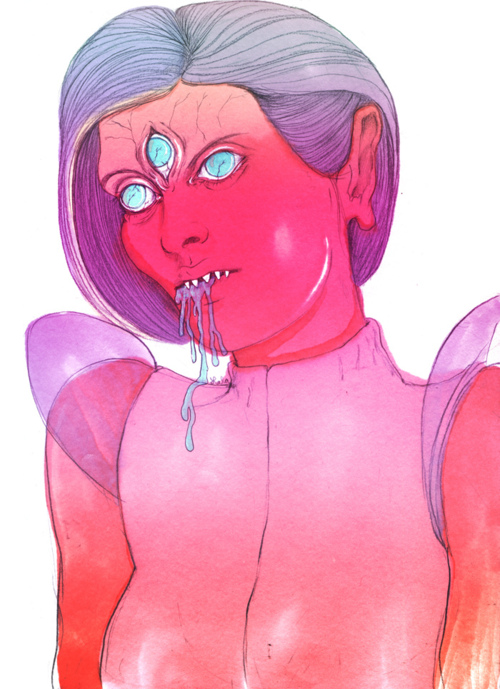
* The 5 Best Things about Pitchfork’s Guest List Best of 2011 feature:
5. The weird way in which Colin Stetson runs down like four or five of my favorite deep cuts from my music library, including the Aphex Twin song during which I discovered that my baby daughter loves to dance
4. One of the Fleet Foxes really likes the X-Men books
3. Seeing which beloved indie rock acts let humanity down by listing Chris Brown songs
2. Seeing which of the Big Three chillwave acts each of the other Big Three chillwave acts does or doesn’t list
1. The concluding paragraph of the list from Ishmael Butler from Shabazz Palaces
Carnival of souls: Joe Simon, Inkstuds, Tom Spurgeon, more
December 20, 2011* I should have noted this last week, but I lost the link in my RSS reader: Captain America co-creator Joe Simon has died. In addition to his achievements as a writer, artist, and editor, and his role as one of Jack Kirby’s first and finest collaborators, as a font of first-hand information about the dawn of comic books — I interviewed him myself a couple of years ago; the sensation was like getting to ask Peter about the Last Supper — he was invaluable to journalists and historians. He also tenaciously fought Marvel Comics for his best-known creation very late in his life, and appears to have won, as he would define it. An inspiring figure.
* The Inkstuds Best of 2011 Critics Roundtable, featuring Tim Hodler, Joe McCulloch, Matt Seneca, and host Robin McConnell, could easily make a Best Comics Criticism of 2011 roundtable somewhere else. Radio really suits all four figures, and the discussion is lively, with each critic clearly springboarding off the others’ ideas.
* Tom Spurgeon’s Holiday Interview series has begun! This is seriously one of my favorite things about the holidays now — curling up on the couch with my in-laws’ dogs and reading one of the best in the business interview some of the best in the business. First up this year is Art Spiegelman and Tom Neely, Emily Nilsson, and Virginia Paine of Sparkplug Comic Books.
* Guy Delisle on Kim Jong-il. I need to re-read Pyongyang.
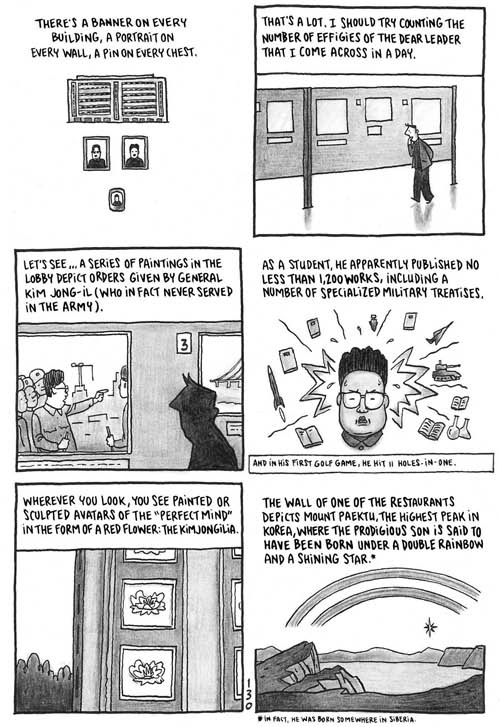
* Frank Miller on late capitalism (unintentionally). (PS: Jesus were he and Lynn Varley ahead of their time, artistically.)
* Happy ninth birthday, AdHouse Books!
* Matt Furie and Lisa Hanawalt are doing children’s books for McSweeney’s. My daughter seems to love froggies, so I’m thinking I’ll check these out.
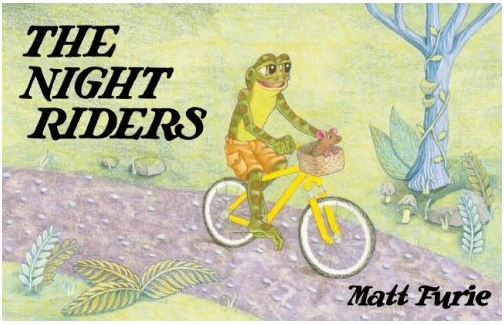
* It’s the Cindy & Biscuit Christmas Special! Dan White is crazy talented.
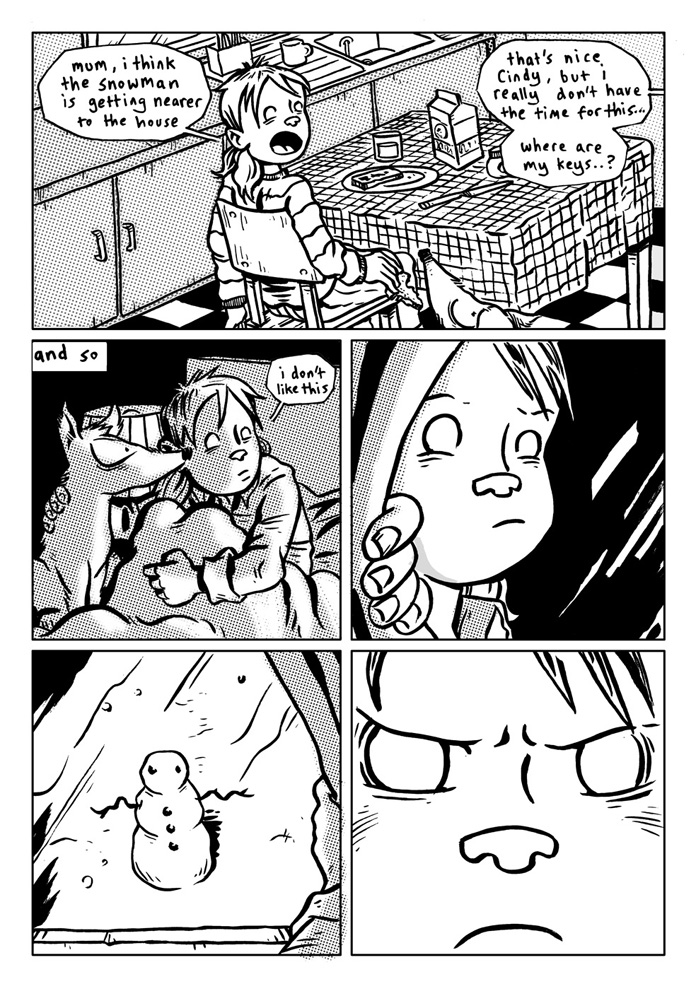
* “Marvel already seems to have origin series galore; they just don’t seem very interested in keeping them in print.” So true. Every Christmas I think about trying to snap up the great Silver Age runs in some easy way — through the giant omnibuses; through the trade paperback versions of the Marvel Masterworks collections — and every year I discover this is next to impossible because nothing’s ever kept in print. You can’t go on Amazon and buy the entire Lee/Kirby Fantastic Four or Lee/Ditko Amazing Spider-Man in a handful of clicks, and that’s a crime. You in fact can’t do it at all, which is worse than a crime, as they say.
* Tom Brevoort’s Formspring has yielded the clearest encapsulation of fannish desire for fiction to work like a rulebook that I’ve ever had the misfortune of reading. I dunno how he puts up with these folks.
* I love that Tom Kaczynski loves the ladies.
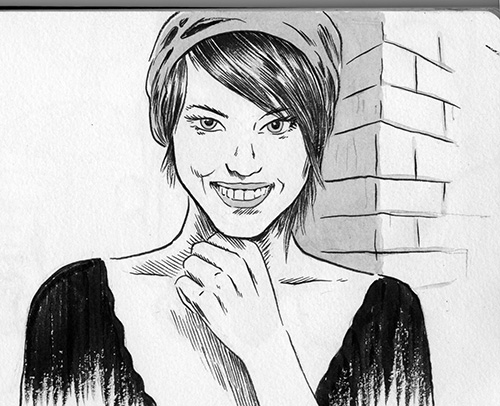
* And on the flipside of the loveliness coin — although they do have the crazy eyes in common — this is some strikingly gross art from Lala Albert.
* Finally, Uno Moralez’s comic from Chameleon #2 is now up on his LiveJournal. It’s as luminous and odd as everything he does.
Comics Time: Mome Vol. 22: Fall 2011
December 20, 2011Mome Vol. 22: Fall 2011
Zak Sally, Kurt Wolfgang, Jordan Crane, Chuck Forsman, Steven Weissman, Sara Edward-Corbett, Laura Park, Tom Kaczynski, Joe Kimball, Jesse Moynihan, Josh Simmons, The Partridge in the Pear Tree, Malachi Ward, Eleanor Davis, James Romberger, Derek Van Gieson, Michael Jada, Tim Lane, Nate Neal, Wendy Chin, Anders Nilsen, Tim Hensley, Lilli Carré, T. Edward Bak, Nick Drnaso, Joseph Lambert, Paul Hornschemeier, Sergio Ponchione, Nick Thorburn, Dash Shaw, Ted Stearn, Jim Rugg, Victor Kerlow, Noah Van Sciver, Gabrielle Bell, writers/artists
Eric Reynolds, editor
Fantagraphics, 2011
240 pages
$19.99
Buy it from Fantagraphics
Buy it from Amazon.com
For today’s Comics Time review, please visit The Comics Journal.
Comics Time: The Man Who Grew His Beard
December 19, 2011The Man Who Grew His Beard
Olivier Schrauwen, writer/artist
Fantagraphics, 2011
112 pages
$19.99
Buy it from Fantagraphics
Buy it from Amazon.com
I love the disconnect between how big and broad this substantial softcover feels in your hands — at 8.5″ x 10.25 ” it’s just wider enough than your average graphic novel for you to notice it — and how tiny the little mustachioed men who people most of its stories feel on those big pages, even when they’re blown up big enough to occupy most of that real estate. It makes it feel even more alien than it already does, like you’re reading a giant’s minicomic.
I don’t know how he does it, whether it’s something to do with how he puts his lines down on paper or some treatment he gives them afterwards, but Flemish cartoonist Olivier Schrauwen makes images that look like…like they’ve been transmitted from a great distance, both temporally and spatially. He’s playing with style and design that looks like it predates the Great War, and his line and coloring has a hazy feel to it that could be a copy of a copy of a copy, or the unlikely discovery of some microscopic cartooning culture blown up to many times its original size. There’s something off about it just as surely as there’s something off about Al Columbia’s rotted vintage visuals, only here that off-ness is used in service of a comic surrealism rather than a horrific one. He can stick it to the foibles of the 19th-century culture whose style he’s swiping quite effectively — savagely satirizing Belgium’s bloody misadventures in Africa, parodying the West’s penchant for physiognometric pseudoscience with a look at what your hairstyle says about your mental capacity, lampooning the world-conquering bravado of transcontinental rail, and so on. But he’s just as likely to seize upon some strange effect or idea and run with it as hard and as fast as he can — nearly literally, in once case, in a strip consisting more or less solely of a guy running to catch a train for as long and as far as the train would have taken him to begin with. Elsewhere, he shatters sexual idylls into a fractal feedback loop or draws its participants as lounging subjects of some kind of weird cubist stained-glass art style; portrays a man who can paint things into existence by trotting him through a series of guffaw-inducing mock-heroic poses, as if his miraculous creative abilities were only secondary proof of his awesomeness compared to his theatrical, bare-chested machismo; and uses bright color and titanically ornate architecture against bland ones to paint a portrait of a catatonic man’s rich and adventurous interior life of fun with a beautiful woman and a beloved child, in a story that ended up being actually quite moving. These are deeply strange short stories, centered on ideas and effects I’m not sure I’d have come up with even with the proverbial infinite number of monkeys at my disposal; even in this short-story-saturated alternative comics climate, there’s nothing else like his gestalt of finely calibrated nonsense. It’s good to see that comics can do things you’d never think to ask of them in the first place.
Comics Time: Mome Vol. 21: Winter 2011
December 16, 2011Mome Vol. 21: Winter 2011
Sergio Ponchione, The Partridge in the Pear Tree, Josh Simmons, Dash Shaw, Steven Weissman, Kurt Wolfgang, Sara Edward-Corbett, Nicolas Mahler, Tom Kaczynski,
Josh Simmons, Jon Adams, Nate Neal, T. Edward Bak, Michael Jada, Derek Van Gieson, Nick Thorburn, Lilli Carré, writers/artists
Eric Reynolds, editor
Fantagraphics, 2011
112 pages
$14.99
Buy it from Fantagraphics
Buy it from Amazon.com
It was the best of Momes, it was the worst of Momes. Alright, that’s not quite accurate, and not quite fair, either. But this unwittingly penultimate issue of Fantagraphics’ long-running alternative-comics anthology — page for page the longest-running such enterprise in American history! — is a hit-or-miss affair in the mighty Mome manner. In the miss column you can place Sergio Ponchione’s bombastic, cartoony fantasy about an imaginary childhood friend brought to life; there’s really not much more to it than that description would indicate. Ditto Kurt Wolfgang’s next “Nothing Eve” chapter, which continues to work the “people still act pretty much the same even though the end of the world is coming” buttons it’s been mashing since issue #1. T. Edward Bak’s “Wild Man” remains awkwardly paced due to its split-up narrative captions; Nicolas Mahler’s autobio strip remains of limited interest to people not Nicolas Mahler; Lilli Carré’s contribution is nicely colored in reds and blues but otherwise insubstantial.
A few contributions are both hit and miss at once. Sara Edward-Corbett’s near-wordless reverie involving inanimate objects romping around the outside of a house comes across more inscrutable than mysterious, but at the same time her crosshatching and linework are an absolute marvel, and she’s playing with forms (and with form) in a fashion reminiscent of John Hankiewicz, if not as successful. Steven Weissman’s deadpan “Barack Hussein Obama” strips fall flat when they merely parody the rhythms of four-panel gag comics, but spring to surreal and oddly scathing life when he injects a healthy dose of the sinister supernatural into them. I’ve never quite cottoned to the way Jon Adams’s razor-thin line and labored-over character renderings sit against the large white expanses of his pages, and his writing feels overwrought to me, but he does give his blackly humorous tale of a hunting expedition gone bad a laugh-out-loud visual punchline. And Nate Neal’s caveman morality play makes much better use of his meaty cartooning than his lukewarm slice-of-lifers do, though the conceit of gibberish dialogue from the cavepeople conceals more than it illuminates.
So that leaves the hits, and they’re strong enough to make the book worth checking out. Dash Shaw continues his seemingly ongoing series of adaptations of “reality” programming, this time an excerpt from a making-of documentary about Jurassic Park; he has a really sharp and off-kilter eye for people observing and commenting on their own behavior for a camera, and his transition from talking heads to full documentary “footage” is a gleeful one. Nick Thorburn’s take on Benjamin Franklin, a first-person monologue in which Ben lets us in on a dirty little secret, is anachronistically absurd (“In Seventeen-Sumthin’-Er-Other, right before I invented electricity and just after I’d sired my illegitimate son, I received an e-mail from Lord Sandwich about comin’ to London to take part in this new secret society known as ‘The Hellfire Club.'”) and very funny, with a great undergroundy character design for Franklin himself. Derek Van Gieson’s murky World War II period piece continues to stun from page to page. Tom Kaczynski examines home ownership during terminal-stage capitalism as only he can, casting it as a catalyst for powerful erotic and apocalyptic impulses and proving himself once again to be one of the most stealthily sexy cartoonists working today. “Stealthy” isn’t a word I’d use for Josh Simmons, but he doesn’t need it: His weird psychedelic fantasia on racism “The White Rhinoceros” is as bold and bulldozing as the giant slugs who stampede across its pages, and the elliptically concluded short story “Mutant” ends with an image of an enraged creature in the form of a human female, her nude body shadowed but covered in glistening sweat, that may as well symbolize the workings of Simmons’s entire brain. You gotta take the rough to find the diamonds.
Carnival of souls: Tom Neely, Craig Thompson, BCGF aftershocks, more
December 15, 2011* Wow, Kristy Valenti interviewed the bejesus out of Tom Neely for The Comics Journal. It’s certainly a must for fans of The Blot or The Wolf, but even if you’re not it’s worth your time just as a portrait of an artist. I explain a bit more about that over at Robot 6.
* Craig Thompson is working on three new books: one’s all-ages, one’s non-fiction, and one’s erotica. It’s like he got zapped with that beam that split Superman into Superman Red and Superman Blue back in the day.
* Bill Karatlopoulos’s essay on Daniel Clowes’s superhero comic The Death-Ray doubles as an excellent capsule history of comics’ rise to pop-cultural and media prominence in the early to mid ’00s. That New York Times Magazine cover story was a true “Made it, Ma! Top o’ the world!” moment; I’m not sure it’d be possible for people who entered comics after it to appreciate what an Event it was.
* Massive BCGF haul review/report from Kevin Czap. And it’s only Part One!
* Ryan Cecil Smith’s stealthy BCGF debut SF Supplemental File #2B is now available outside the Closed Caption Comics #9.5 box set. It looks purty. Riso printing, amirite?
* Excuse me while I wolf whistle at this page from “Forces” by Noah Butkus, out of the Happiness Comix anthology that I now wish I’d made a point of picking up at BCGF. Good gravy!
* Real Life Horror: Drones in America.
* But let’s end on a couple of up notes: In light of the news that Christopher Meloni is joining the cast of True Blood, Jason Adams asks the only question that matters.
* And there’s nothing I could say about this selection of photographs from a Van Halen in-store signing appearance from 1978 that could possibly top 33 1/3’s John Mark’s assessment for accuracy: “The kids in these pictures are the very definition of ‘at-risk teens.'”
Comics Time: Like a Sniper Lining Up His Shot
December 15, 2011Like a Sniper Lining Up His Shot
Jacques Tardi, writer/artist
Adapted from the novel by Jean-Patrick Manchette
Fantagraphics, 2011
104 pages, hardcover
$18.99
Buy it from Fantagraphics
Buy it from Amazon.com
Fantagraphics keeps churning out lovely translated editions of the work of French comics master Jacques Tardi at a truly admirable clip. This is the fourth in what I would consider the “main” Tardi/Fanta line of slim hardcovers, distinguished by no-nonsense Adam Grano cover designs that juxtapose key sequences from Tardi’s ink-soaked black-and-white interior art with bold slashes of color and block-caps for title and credit information. If there’s a better mesh of form and function in comics right now this side of, well, Fanta’s similarly designed Love and Rockets digests, I’d sure love to see it. In much the same vein as Tardi’s previously released adaptation of a crime novel by author Jean-Patrick Manchette, West Coast Blues, Like a Sniper Lining Up His Shot is a grimly economical story of a man on the run from killers, with bursts of violence that slash in out of nowhere. In other words, you can judge a book by its cover.
The two books have much in common beyond their common language of men hunted by hitmen across the length and breadth of France. Both protagonists are bizarrely taciturn about their predicaments, almost to the point where you’re left to wonder if there’s some sort of mental disability involved. Sniper‘s Martin Terrier (great name) at least has the excuse of being a mercenary and assassin to explain his flat affect where killing’s concerned, as opposed to West Coast Blues‘ wrong-man family-guy George. But he more than makes up for this in his personal life, a disaster area predicated entirely on his deeply weird belief that the women with whom he involves himself can switch their affections for him on and off after years of one setting or the other based solely on his say-so. The woman for whom he “risks it all” — Tardi and Manchette’s interpretation of this trope ladles those sneer quotes all over it — is an equally weird and unpleasant character, ricocheting from emotion to emotion when Terrier’s intrusion into the life she’d been leading without him violently upends her status quo, until finally settling on some weird sneering sex-hungry brand of derision for him and his life of crime and adventure.
In all honesty, these emotional and behavioral patterns are so difficult to recognize even when allowing for the remove between a hired gun and a comics critic that they get in the way of Tardi and Manchette’s underlying indictment of society’s casual savagery, and its propensity for covering up that savagery with bullshit that pins it on The Other Side. But upon reflection, I wonder if these terrible people’s wholly alien way of interacting with the world isn’t just the writing equivalent of Tardi’s nimble, scribbled line and sooty blacks — a heightened reality in which things are rendered at their loosest, darkest, ugliest, and weirdest at all times. God knows both creators can rigorously focus when they want: Manchette squeezes a quite believable custody battle between Terrier and his now-ex girlfriend over a beloved cat into the proceedings, while Tardi’s backgrounds and lighting effects are a realist’s dream and his action sequences and set-pieces are choreographed tighter than a drum. The absurdist demeanors may prevent everything from gelling as well as they might have done, but overall the book delivers a fastball to your face so hard that you barely have time to notice that some of the stitches need straightening.
Carnival of souls: Game of Thrones, BCGF, more
December 12, 2011* There’s a new teaser trailer for Game of Thrones Season Two. It centers on one of the new characters being introduced this season, which puts me in mind of several other shows that have introduced major new antagonists after their debuts and how they’ve positioned them relative to the preexisting players.
* Related: I’m not sure if I’ve ever mentioned this, but my A Song of Ice and Fire tumblr All Leather Must Be Boiled has a whole lot of ASoIaF/GoT art/fanart on it. Today I posted this grim painting of the Riverlands by Rene Aigner, which says a whole lot about the series.
* More BCGF: L. Nichols flips the eff out over the show;
* and PictureBox stocks up on many of its highlights and hidden gems for its online store.
* More Jerusalem preview pages from Guy Delisle. This is shaping up to be a really lovely book.
* I don’t think there’s an easy way to link you to all of it, but sniff around Benjamin Marra’s Traditional Comics tumblr for a lot of art from his series of American Psycho tribute booklets.
* The Comics Journal presents a look at four prominent alternative-comics retailers by Patrick Rosenkranz. The amount of thought and creativity they put into promoting the comics they sell and attracting the audience that buys them is both inspiring and a little depressing, in terms of how much time and energy you need to invest if you wanna make a go of this sort of thing.
* Entertaining speculation about the evolutionary origins of monsters in the human mind, the idea being that early man’s brain combined features of all the animals it was worried about getting attacked by into creatures like dragons and such, as a kind of shorthand for “LOOK OUT, DANGEROUS ANIMAL!” (Via Andrew Sullivan.)
Carnival of souls: Jerry Robinson, my BCGF con report, more
December 9, 2011* Cartoonist Jerry Robinson has died at age 89. In addition to creating the Joker, co-creating Robin, and basically co-creating what we all picture as “Batman” in terms of the concept’s look and cast, he was a pioneering comics historian and creators’ rights advocate — proof that even those who benefited from the system didn’t have to shy away from trying to better it.
* My BCGC con report can be found at Robot 6. I really like this show — a mainline hit of exactly what I love about comics today — and tried to articulate what sets it apart from comparable cons.
* Secret Acres’ dynamic duo of Barry and Leon always whip up the most well-written con reports, and this time is no exception. I don’t know how they do it. You really get a sense of their whole experience — creative, commercial, cultural, communal.
* Kevin Czap had one heck of a con haul! His brief overview articulates something I’d sort of picked up on myself, which is that Kramers Ergot is now the elder statesman of artcomics anthologies rather than the place you go to find shit you’ve never seen before. It’s interesting how the new volume’s more restrained and refined approach feeds into that vibe.
* And Nick Gazin at Vice has the best of the photo parades. Plus, if you are interested in finding out whether or not he personally finds a given woman cartoonist physically attractive, then boy howdy is it a treasure trove of information. No word on how hot he finds Dan Nadel, pictured below. (Via Jonny Negron.)
* Big get alert: Drawn and Quarterly is picking up Gilbert Hernandez’s forthcoming semiautobiographical graphic novel Marble Season. This could be a pretty interesting effort — I mean, okay, it’s Beto, so it’ll definitely be a pretty interesting effort. But what I mean is that a) the stuff he does for publishers other than Fantagraphics is usually off-brand for him in ways that demand examination, and b) by the sound of it, it’s an account of his childhood love of comics, which means it probably will eschew the extreme sex and violence of most of his Love and Rockets and Fritzverse work these days, and thus may help the audience appreciate just how good he is lately without those potential impediments if that’s not their thing.
* Holy — The 2011 and 2012 J.R.R. Tolkien Calendars featured Cor Blok?? It’s so refreshing to see artists interpret epic fantasy without working in the hyperreal visual tradition — cf. yesterday’s Danger Country review — and Blok was one of the best at it. The first time I saw his Tolkien art was a true revelation. Look what you could do with this material! (Via Tom Spurgeon.)
* I love it when Zak Smith/Sabbath just tosses out dozens and dozens of great fantasy storytelling ideas like it ain’t no thing. Today he’s doing it with barbarian cultures. Come for the ideas, stay for the oblique George R.R. Martin diss!
* Here’s a sharp little essay from Matt Seneca on John Romita Sr., “the quintessential Marvel artist.” The other week Tom Spurgeon got some José Luis Garcia-Lopez DC character art going around, so I said something on twitter about how José Luis Garcia-Lopez is to DC what John Romita Sr. is to Marvel, that they’re equivalently definitive artists for their respective publishers’ visual identities. Matt says the same thing in the comments. (Romita trumps Garcia-Lopez in terms of the comics themselves.)
* Whoosh, this Sam Hiti piece is hot stuff. (Via Sam Bosma.)
* My favorite band, Underworld, have been named music directors for the opening ceremony at the 2012 Olympics in London. Their longtime collaborator Danny Boyle is the artistic director. And so I’ll be watching some of the Olympics!
* A Goldfrapp singles collection could go a long way to showing just how strong their repertoire is. Most underrated band of the ’00s.
* Kiel Phegley reminds us that this is what Yvonne Craig looked like.
* I feel I’ve been lax in my duty to direct you to my tumblr for photographs of Beyoncé Knowles and David Bowie, Bowie Loves Beyoncé. Perhaps this will remedy that in some way. Some wonderful way.
* Finally, start the weekend off right with an Uno Moralez image/gif gallery.
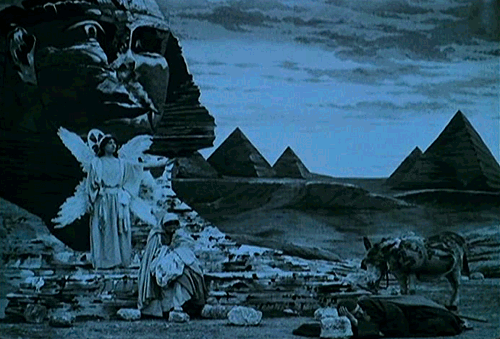
Comics Time: The End of the Fucking World Part One
December 9, 2011The End of the Fucking World Part One
Chuck Forsman, writer/artist
self-published, December 2011
12 pages
$1
Buy it from Oily Boutique
How’s that for a title? And I’m pleased to say the contents are just as good. Forsman has become a must-read talent for me; each new minicomic shows growth. He’s a cartoonist of great restraint, in terms of both visuals (this is all slight, feathery lines and quiet, flat-affect “acting” from the characters) and pacing (this is all no-nonsense page-long vignettes, with dialogue and captions strategically deployed for a steady beat-beat-beat rhythm). His characters themselves feel considered and lived-in. The lead character here is a believably blasé creep recounting his childhood, marked by killing animals, mutilating himself, and discovering his inability to feel love or have a sense of humor. But thanks to a terrific hesher character design, his evident sociopathy come across not like some heavy-handed depiction of a budding Ted Bundy but like a satire of run-of-the-mill teenage-dirtbag-ism. He’s like Beavis Bateman.
These two potentially opposing views of our hero come together in the story’s centerpiece, the four pages dedicated to his going-through-the-motions relationship as a 16-year-old with his pretty, forward girlfriend Alyssa. It’s easy to see how his aloofness could come across as attractive, and the resulting, detailed depiction of skewed adolescent sexuality is as skeevy and funny and sexy and creepy as they come. He fantasizes about strangling her as she tells him “God, I want you” takes off her shirt; their tongues intertwine like snakes on a caduceus; he presses his face to the convex arc of her stomach as she presses his head down toward her underwear; they have the following amazing exchange as they snuggle on the couch watching TV:
“Have you ever eaten a pussy before?”
“Sure.”
“I want you to eat mine.”
“Right now?”
The awkwardness, the urgency, the sense of discovery, the sense of revulsion — it’s all true, even if you’ve never stuck your own hand in a garbage disposal on purpose or crushed a stray cat with a stone. Where those aspects of the story will take us is something I’m greatly looking forward to seeing in future issues, given where we’ve gone here.

